Henry Jenkins's Blog, page 9
April 5, 2023
The Sound of Protest: Bollywood’s Jimmy Jimmy and COVID unrest in China
In October 2022, following a Covid outbreak, factory workers in China began protesting the Chinese government’s stringent measures to control the spread. What followed was a series of protests against lockdowns and the government’s closed-loop management system that did not allow factory workers to leave the factory; this led to the virus spreading rapidly among the workers. The government came down heavily on the workers in trying to curb the protests. While the factory workers voiced their protest on the street and online, another subtler wave of online protest emerged as humor through the sound of Bollywood. The Chinese Tik Tok Duoyin abounded with videos of Chinese netizens (Internet citizens) singing Jimmy, Jimmy a popular Bollywood song from the 1980s. Jimmy Jimmy, however, is not just any Bollywood song; it was the youth anthem for many soviets and east Europeans in the eighties. In this post, we focus on primarily three aspects of this event. First, what qualities make a song a protest song? Second, how do we account for the transcultural, trans-linguistic flow of the song, and what does this exchange reveal about the cultural dissemination and absorption of Bollywood in China?
Why Jimmy Jimmy?
The song Jimmy Jimmy from the Bollywood film Disco Dancer (1984) has historically enjoyed a global resonance. In a time when the Soviet Union did not allow American exports, the sound of Disco made its way to the USSR and Eastern Europe through Bollywood. The song has had an interesting afterlife in the post-Soviet digital space through performers like Baymyrat Allaberiev, whose rendition of Jimmy Jimmy in 2009 brought back the Disco Dancer phenomenon, leading to multiple versions, performances, and renewed digital fandom. In the context of the circulation of the manifold Tajik and Uzbek versions of Jimmy Jimmy, Chapman notes that past film materials provide rich dispersed content that can often be reified with new meanings.[1] The digital in this context provides a fecund space for the osmosis of Bollywood’s malleable cultural form within transcultural spaces.
However, the question still bears asking, why Disco Dancer? The very specific kind of technological and capitalistic bent of Disco was unique, but it became a distinctive amalgamation when fused with Bollywood’s expressionistic and melodramatic overtones. Its catchy lyrics, over-the-top mise-en-scene, and melodrama entwined together to lend it a malleable quality that overlays well with the discursive malleability of the digital - that is ever-changing and evolving.
There are multiple factors that go into creating the digital malleability for Jimmy Jimmy. First, is the music and ease of lyrics. Second, is the sound of Disco “mix” that is more immediately subversive and situates the audience as the true star of the show. The hedonistic, subversive quality of disco comes together seamlessly in its Bollywood iteration with Jimmy Jimmy’s excessive and melodramatic mise-en-scene. It, therefore, became the perfect globally malleable Bollywood sound that is equally availed of by the Tajiks or the Chinese.
The performative sentimental excess in a film like Disco Dancer lends it a camp quality that is further accentuated by Disco. In protesting the state-imposed oppressive Covid restrictions, China’s netizens leaned into the malleable quality of the song and its Bollywood aesthetic. What was being performed was a queering of the Bollywood aesthetic wherein the Chinese performers of Jimmy Jimmy donned androgynous digital avatars through filters (See images below). The political resonance of the moment juxtaposed with the campy quality does not diminish the citizen videos’ political import. It rather accentuates it by couching a subversive protest by queering and highly stylizing the performance. The parodic adaptation of Jimmy Jimmy, in this instance, works as a political tool and strategy of subversion that allows them to escape direct state censorship yet communicate their protest musically.
1. Chinese Jimmy Jimmy — Douyin
2. Chinese Jimmy Jimmy — Douyin

figure 1: Screenshots from Jimmy Jimmy Performances on Chinese Tik Tok Douyin
Why Tik Tok? Platform MediationThe production, circulation, and reception of protest songs have become increasingly contingent upon the specific affordances of social media platforms such as Twitter, Instagram, YouTube, and TikTok/Douyin. Specifically, in the case of rapid popularization of the Chinese renditions of Jimmy Jimmy on TikTok and Douyin, the televisual appeals of short video formats attract ordinary people to upload and share songs and comic performances in the first place, even when cultural producers might face tight censorship and surveillance in authoritarian states like China. The platforms’ algorithmic recommendation system further enables its over 1 billion users to quickly discover viral content, both within and beyond the Great Fire Wall (a euphemism for the censorship system in China). Moreover, netizens could share viral short videos from the platform of their origins to other platforms such as Instagram and Twitter. The multi-platform migration of a protest song like Jimmy Jimmy in social media, together with the accelerating news production cycles at news agencies around the world, provides further affordances for popularizing protest songs like Baraye and Jimmy Jimmy.
The popularization of a parody version of Jimmy Jimmy in the Chinese Internet needs to be situated in the tightening censorship and surveillance systems in China, particularly during its draconian zero-Covid policies in recent years. Since the early 2000s, Chinese netizens have created an Internet culture of “e-gao” through satire, parody, punning, spoofing, and mockery in countering official discourses and policies.[2] For example, netizens coined the meme of a “grass mud horse” (meaning “fuck your mother”) to implicitly criticize the government’s Internet policies in the late 2000s. Since then, the image of a “grass mud horse,” together with other made-up “mythical creatures” (shenshou), has become a symbol of resistance against censorship. During the global pandemic of COVID-19, apart from protest songs like Jimmy Jimmy, people have resorted to various forms of online parody and dark humor to express their discontent and dissent. On many college campuses, for instance, students under long lockdowns made paper pets and uploaded the photos and videos of them walking those pets on campus. Women podcasters, rather than directly criticizing the lockdown policies, humorously chatted about their experiences as a way to “make sweetness out of bitterness.”[3] The flourishing of online parody and humor attests to the resilience of Chinese netizens in dodging and dealing with censorship on a daily basis.
Besides satire and parody, translation also plays a crucial role in resisting censorship in China. Broadly speaking, translation is the practice of bringing the meanings of a given text across to another context through a certain medium. In China, translation of a specific text - be it televisual, audio, textual, architectural, or bodily - is a common tactic of protest in cyberspace.[4] One prominent example is that during Wuhan Lockdown, netizens used translation to relay messages that had been censored by the state.[5] The protest song based on the translation of the original Bollywood song Jimmy Jimmy is another powerful example of how translation and satire work together as a gesture of playful resistance against government censorship and covid policies.
Translation, in the case of Jimmy Jimmy, works through specific tactics of anonymity, transliteration, dubbing, and bodily performance. To start with, while the song became a hit within a few days on social media, the anonymous translator of the original lyrics remains unknown as of today. Thus, no individual could be potentially incriminated by the government. Moreover, the translation of Jimmy Jimmy into a protest song is, in fact, a process of mistranslation through transliteration. The original soundtrack is in Hindi; sometimes, English transliteration is displayed as well. The Chinese translation is often displayed on the screen as follows:
Jimmy
借米 (jie mi)
[Can I] borrow rice?
Aaja
哪家 (na jia)
Which family?
Jimmy
借米 (jie mi)
[Can I] borrow rice?
Aaja
俺家 (an jia)
[It’s] my family.
俺家里没米了(an jia li mei mi le)
My family does not have rice now
你家里有米吗?(ni jia li you mi ma)
Does your family have rice?
少拿点不需多 (shao na dian bu xu duo)
Take less, you don’t need more
Hindi Transliterated Lyrics Jimmy Jimmy Jimmy, aaja aaja aaja
English Translation Jimmy Jimmy Jimmy, come come come
Hindi Jimmy Jimmy Jimmy, aaja aaja aaja
English Jimmy Jimmy Jimmy, come come come
Hindi Aaja re mere saath
English Come with me
Hindi Yeh jagi jagi raat
English This night is without any sleep
Hindi Pukare tujhe sun
English Listen, it's calling for you
Hindi Suna de wohi dhun
English Sing the same tune for me
Hindi Jimmy Jimmy Jimmy, aaja aaja aaja
English Jimmy Jimmy Jimmy, come come come
Hindi Jimmy Jimmy Jimmy, aaja aaja aaja
English Jimmy Jimmy Jimmy, come come come
Hindi Aaja re mere saath
English Come with me
Hindi Yeh jagi jagi raat
English This night is without any sleep
Hindi Pukare tujhe sun
English Listen, it's calling for you
Hindi Suna de wohi dhun
English Sing the same tune for me
Hindi Jimmy Jimmy Jimmy, aaja aaja aaja
English Jimmy Jimmy Jimmy, come come come
Hindi Jimmy Jimmy Jimmy, aaja aaja aaja
English Jimmy Jimmy Jimmy, come come come
Hindi Aise gum-sum tu hai kyun khamoshi tod de
English Why are you quiet, break your silence
Hindi Jeena kya dil haarke pagalpan chhod de
English Don't lose your heart and live, don't be mad
Hindi Aise gum-sum tu hai kyun khamoshi tod de
English Why are you quiet, break your silence
Hindi Jeena kya dil haarke pagalpan chhod de
English Don't lose your heart and live, don't be mad
Hindi Aaja re mere saath
English Come with me
Hindi Yeh jagi jagi raat
English This night is without any sleep
Hindi Pukare tujhe sun
English Listen, it's calling for you
Hindi Suna de wohi dhun
English Sing the same tune for me
Hindi Jimmy Jimmy Jimmy, aaja aaja aaja
English Jimmy Jimmy Jimmy, come come come
Hindi Jimmy Jimmy Jimmy, aaja aaja aaja
English Jimmy Jimmy Jimmy, come come come
Hindi Jimmy aaja, Jimmy aaja
English Jimmy come, Jimmy come
Hindi Aaja re mere saath
English Come with me
Hindi Yeh jagi jagi raat
English This night is without any sleep
Hindi Pukare tujhe sun
English Listen, it's calling for you
Hindi Suna de wohi dhun
English Sing the same tune for me
As shown above, the Chinese lyrics phonetically mimics the Hindi lyrics but comes with new meanings. The opening line “Jimmy” is translated as “jie mi” (borrow rice) in pinyin, the official romanization system for Standard Mandarin Chinese in China, which becomes the most catchy phrase from the song. The term “aaja” is translated into two different Chinese meanings - one is “which family” and the other “my family” - which create a sense of a dialogue. The lines go to recreate a scene in which one is borrowing rice from someone else, perhaps their neighbors. This is a common scene during the COVID lockdowns when food supplies were short and people had to try everything they could to feed themselves. There have been many stories of people coordinating group-buying, crying out for help for their kids or the elderly, and helping both strangers and neighbors. The joyful lyrics and the playful bodily performance in the viral short videos, in a sense, remind people of the painful experiences of the constant fear of starvation and the lack of freedom to express their anger and frustration in public. The musical sound of Jimmy Jimmy despite its apparent sentimental campy frivolity embodies the subversive, performative potential of the sound of protest all the way from Tajikistan to China.
[1] For more see “Performing ‘Soviet’ film classics: Tajik Jimmy and the aural remnants of Indian cinema” by Andrew Chapman in Studies in Russian and Soviet Cinema.
[2] Li, Hongmei. "Parody and resistance on the Chinese Internet." Online society in China. Routledge (2011): 71-88.
Meng, Bingchun. "Regulating e gao: Futile efforts of recentralization?." China's information and communications technology revolution. Routledge (2009): 64-79.
Yang, Guobin, and Min Jiang. "The networked practice of online political satire in China: Between ritual and resistance." International Communication Gazette 77.3 (2015): 215-231.
[3] Wang, Jing. "Lockdown sound diaries: Podcasting and affective listening in the shanghai lockdown." Made in China Journal 7.1 (2022): 151-161.
[4] Zhang, Weiyu, and Chengting Mao. "Fan activism sustained and challenged: participatory culture in Chinese online translation communities." Chinese Journal of Communication 6.1 (2013): 45-61.
Yang, Guobin. "The online translation activism of bridge bloggers, feminists, and cyber-nationalists in China." Media Activism in the Digital Age. Routledge (2017): 62-75.
[5] Yang, Guobin. The Wuhan Lockdown. Columbia University Press, 2022.
Biographies:Swapnil Rai is an Assistant Professor of Film, TV and Media at the University of Michigan, Ann Arbor. Swapnil’s research is concerned with the intersections of politics, popular culture and media industries and brings together global media industry studies, transnational stardom, audience studies and women and gender studies. Her work has been published in a range of scholarly journals including Communication, Culture & Critique, Feminist Media Studies, International Journal of Communication, Jump Cut and Cinephile. Her book Networked Bollywood: How star power globalized Indian cinema is forthcoming with Cambridge University Press. Swapnil is a member of the editorial board of Pop Junctions and a board member of the feminist media collective Console-ing Passions. She tweets @i_swapnil_rai .
Jing Wang is an incoming Assistant Professor in the School of Journalism and Mass Communication at the University of Wisconsin-Madison. She is currently Senior Research Manager at the Center for Advanced Research in Global Communication (CARGC), Annenberg School for Communication at the University of Pennsylvania. Jing’s research focuses on anthropology of Islam, race and ethnicity studies, sound and podcasting, feminist practices and theories, and transnational media. She has published in journals across disciplines such as New Media and Society, Made In China Journal, Asian Anthropology, Terrain: Anthropologie & Sciences Humaines, and Journal of Transformative Learning. Committed to public and multimodal scholarship, Jing co-founded TyingKnots 结绳志 and Global Media & Communication podcast series. You can find her on jing-wang.net and Twitter @JingWang0815.
March 27, 2023
A Bowl of Cherries: Footage of a Forgotten Happening
The following post was created as part of the assigned work for Henry Jenkins's PhD seminar, Public Intellectuals. The goal of the class is to help communication and media studies students to develop the skills and conceptual framework necessary to do more public-facing work. They learn how to write op-eds, blog posts, interviews, podcasts, and dialogic writing and consider examples of contemporary and historic public intellectuals from around the world. The definition of public intellectuals goes beyond a celebrity-focus approach to think about all of the work which gets done to engage publics — at all scales — with scholarship and critiques concerning the media, politics, and everyday life. Our assumption is that most scholars and many nonscholars do work which informs the public sphere, whether it is speaking on national television or to a local PTA meeting.
Life is just a bowl of cherries/— "Life Is Just a Bowl of Cherries," performed by Judy Garland. Original music by Ray Henderson and lyrics by Lew Brown, 1931.
So live and laugh at it all.
The satirical featurette A Bowl of Cherries (1961, dir. William Kronick) tells the story of a starry-eyed cowboy, named Sherman Williams, who moves to Greenwich Village with hopes of becoming America’s next great painter. It features prominent cameos by Jim Dine, Robert Whitman, and Lucas Samaras — three major pioneers of the downtown "Happening” scene. These artists introduce our protagonist to the prevailing style of “action painting,” made famous by Jackson Pollock and other Abstract Expressionists, forever altering his worldview. By the time A Bowl of Cherries hit theaters, action painting was on the verge of decline — making it a suitable subject of parody for artworld insiders witnessing these changes in real time.

figure 1: William Glover (AP), “Experimenting Film Director Swings Back into 'Silent'," The Amarillo Globe-Times, March 16, 1961, 20.
As active participants in “Painter’s Theater,” a process-oriented mode of performance art that flourished in the cooperative gallery spaces on Tenth Street in the early 1960s, Dine, Whitman, and Samaras were all experienced actors prior to making of A Bowl of Cherries. These semi-scripted, absurdist shows were staged in elaborate installations cobbled together from everyday objects, urban detritus, and expressionist paintings. Dine mused that the older generation of painters “Would have been embarrassed,” by these self-deprecating and delightfully nonsensical plays: “They would’ve said, ‘This isn’t serious. We are not actors. We are serious intellectuals. We are not circus performers.’” Creators of Painter’s Theater used comedy to puncture the self-seriousness of the prior generation, and to make dead-serious points about the role of art in a culture progressively geared towards mass-spectatorship. Much like Painter’s Theater, A Bowl of Cherries grapples with the legacy of action painting, asking what does art look like after Pollock? And, more existentially, what does an artist look like in a media landscape increasingly fascinated with the New York art world?
After reaching out to the film’s director and writer William Kronick via the comments section on YouTube, I had the opportunity to interview him on the phone on November 23, 2021.

Figure 2: Reaching out to William Kronick via YouTube.
Kronick told me he was inspired to make a film about the downtown art scene sometime in 1959 after reconnecting with his former college roommate, Bruce Glaser, the manager of Camino Gallery (one of several artist-run spaces on Tenth Street). At the time Glaser was dating Natalie Edgar, a painter and critic for ARTnews, who passed the script on to her brother George. A hotshot Wall Street investor keen on getting into the movie making business, George Edgar gave Kronick around $8,000 to make the picture no strings attached. With Glaser as his production coordinator and casting director, Kronick shot the entire film on location in Greenwich Village during a period of about twelve days in September 1960.
According to Kronick, the decision to cast working artists was financially motivated — as it was a vastly cheaper alternative to hiring professional actors. But as a stylistic choice, the casting is in keeping with a larger cultural shift in independent filmmaking towards realism and improvisation. Critic and filmmaker Jonas Mekas identified a new wave of American cinema “intimately linked with the general feeling in other areas of life and art: with the ardor for rock and roll; the interest in Zen Buddhism; the development of abstract expressionism (action painting); the emergence of spontaneous prose and New Poetry — all a long-delayed reaction against puritanism and the mechanization of life.”[1] Mekas points to Pull My Daisy (1959), directed by the photographer Robert Frank and painter Albert Leslie, as an example. Based on a play by Jack Kerouac (who also provides the film’s narration), this short chronicles a dinner party hosted by a railway brakeman and his wife, an abstract painter, featuring a star-studded cast of literary and artistic luminaries including Allan Ginsberg, Peter Orlovsky, Alice Neel, and Larry Rivers. "Pull My Daisy is an accumulation rather than a selection of images. It was made by non-professionals in search of that freer vision.”[2] In 1968 Leslie revealed that the film was in fact not improvised, but thoroughly rehearsed and scripted.[3] Pull My Daisy was successful (at least in part) because people believed the film to be improvised and thus truer to life.
Shot just two years after Pull My Daisy, A Bowl of Cherries operates under a similar fusion of reality and fiction. While the participating artists were not as famous as Ginsberg or Kerouac, they were nonetheless recognizable as “rising stars” in the New York artworld. Their presence in A Bowl of Cherries lends an air of authenticity to the project, enhanced by the film’s reliance on on-location scenery. At times the movie feels like a time capsule of 1960s New York, particularly in its documentation of now-defunct artists co-ops on Tenth Street, as the protagonist wanders through the actual, moving cityscape of Greenwich Village. However, the authenticity of the scene is doubly ruptured by the character’s ridiculous cowboy get-up and the flickering frame rate associated of a turn-of-the-century silent film.

figure 3: Fred McDarrah, View of Tenth Street Galleries, c. 1960

figure 4: View of Tenth Street Galleries from A Bowl of Cherries.
By toying with the aesthetic conventions of an old slapstick comedy, A Bowl of Cherries presents a proximate simulation of the downtown art scene primed for humorous critique. In a promotional interview for the film Kronick stated, “The fact that the actors can't talk, and the motion is unnatural creates a new reality.”[4] In keeping with the genre, the director substituted speech with old-fashioned title cards, which provide context for the pantomimed performances on screen. After reviewing a copy of the original script almost sixty years after the film’s production, Kronick remarked, “I couldn't believe it — I'm reading it and it's exactly the film that we shot. No changes…the title cards were all the same, identical.” From his recollection, the actors received the title cards prior to filming and used them as prompts for improvised action as the camera rolled. The title cards almost never line up with the mimed dialogue on screen, creating an odd dissonance between word and image.
The movie opens as a wannabe painter from the country, with the on-the-nose name Sherman Williams, is dropped off by a man in a convertible on the side of the West Side Highway. The driver is played by Kronick himself.
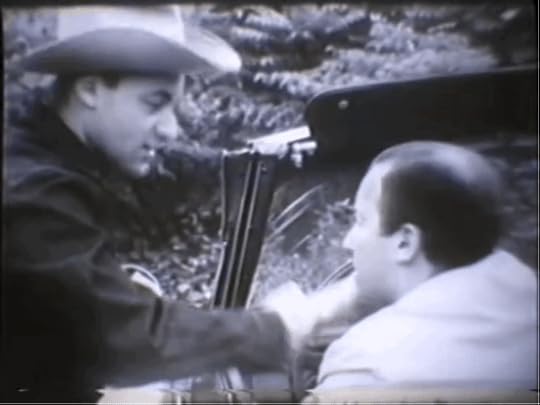
figure 5: Sherman Williams on the West Side Highway, with director William Kronick.
With several rolled-up canvases in hand, Williams dodges oncoming traffic in efforts to make it to the subway station, where he takes the train down to Christopher Street. Upon his arrival downtown he happens upon a group of stylish young women clad in all black, smoking cigarettes in front of Paperback Gallery (a literary hotspot in the Village). When Williams asks them where he can rent an artist’s studio they stare at him with skepticism, followed by a title card that reads: “Man, are you real?”
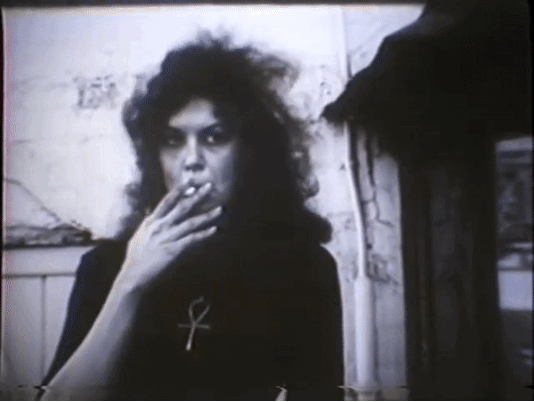
Figure 6: Sylvia Rudolph, Natalie Edgar, and Hilda Ruiz outside Paperback Book Gallery.
Getting the message, the cowboy backs away from the group of women and continues his downtown odyssey. After wandering around the Village, he stumbles upon the storefront of a laundromat advertising studio space for rent. The proprietor, played by painter James Hiroshi Suzuki, leads Williams through rubble-filled alleyways to get to a vacant loft.
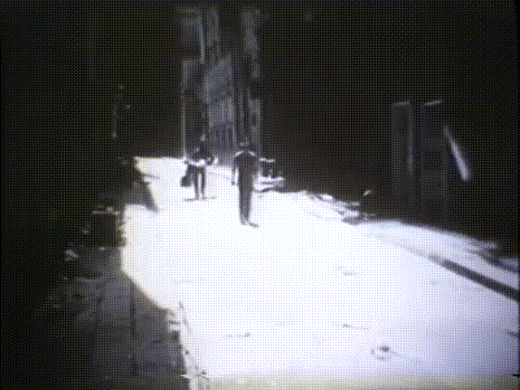
figure 7: James Hiroshi Suzuki leading Sherman Williams to his new studio.
The space, according to Kronick, “was an actual downtown loft…about five blocks away [from the Tenth Street galleries]”. In the film, Williams hands over his life savings to the landlord and begins to hang his artwork up on the blank studio walls. As the cowboy unfurls his canvases, it is revealed to the audience that all of Williams’ paintings feature horses. Could there be a subject more out of step with fashionable New York?
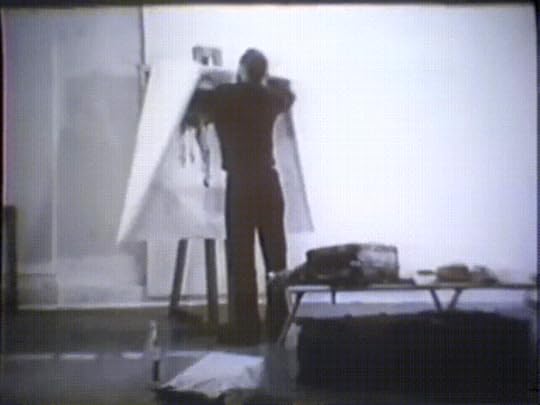
figure 8: Sherman Williams and his horse painting.
After settling into the city, the protagonist finally goes to an art gallery in search of representation. As he walks into the space, he is confronted with abstract painting for the very first time, amounting to what can only be described as a revelatory experience.
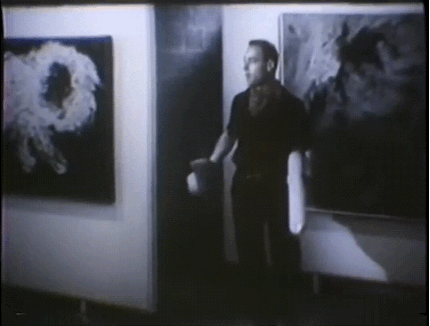
figure 9: Sherman Williams encounters abstract art, and gallerist Bruce Glaser.
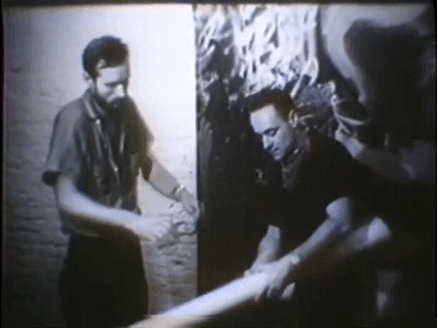
figure 10: Sherman Williams encounters abstract art, and gallerist Bruce Glaser.
Like Dorothy’s arrival in Oz, the film suddenly switches from black and white to color for a twenty-second interlude. Close-up shots of paintings are juxtaposed with images of Williams’ face, which switches from shock to suspicion, and ultimately satisfaction. Moving back to black and white, the cowboy shows his work to the gallery owner —played by Bruce Glaser. Unimpressed by the horse paintings, the gallerist nonetheless invites Williams to an art opening the following night.
This is where his true initiation into the art world occurs. Kronick shot this scene at an actual opening hosted at Great Jones Gallery, in celebration of a new show of paintings by Vivian Springford. Exhibition ephemera from the painter’s archive inadvertently reveals the filming date of this scene — September 26, 1960 —providing a more precise timeframe for the production of A Bowl of Cherries.
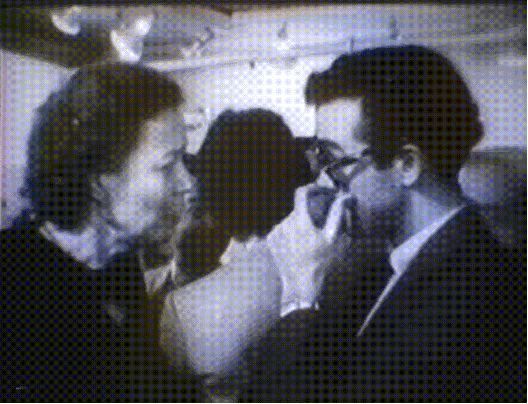

Figure 12: Vivian Springford in A Bowl of Cherries; exhibition ephemera from her exhibition, September 20, 1960.
Springford’s show was curated by critic Harold Rosenberg, one of the most influential proponents of action painting. Rosenberg most likely attended the party, and perhaps even passes by Kronick’s camera (although this is difficult to confirm visually). In the press release for Springford’s exhibition, Rosenberg writes: "a good number of people suspect that all it takes to be a modern painter is a beard, some canvas, and a good paint supply. Presumably, you do not even need a brush to paint abstraction. The reverse is true of Vivian Springford,” — a soak-stain painter in the vein of Helen Frankenthaler or Morris Louis.[5] Springford’s effusive, almost calligraphic paintings float in the background as Jim Dine, Robert Whitman, and Lucas Samaras are introduced on screen for the very first time, under the respective aliases of Benno Moskowitz, Tim Babka, and Max Theodopolous.
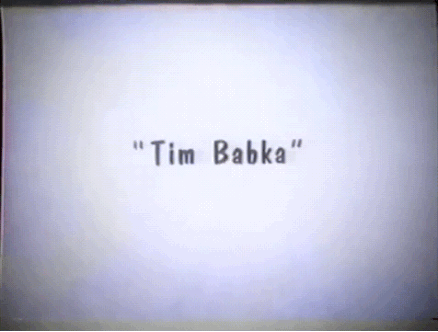
Figure 13: Robert Whitman as Tim Babka, Lucas Samaras as Max Theodopolus, and Jim Dine as Benno Moskowitz.
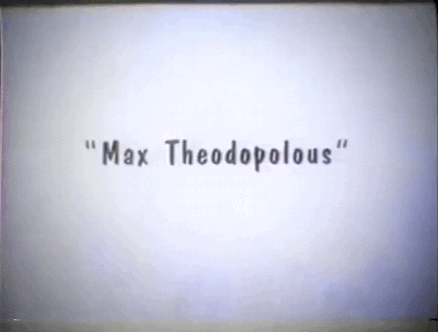
Figure 14: Robert Whitman as Tim Babka, Lucas Samaras as Max Theodopolus, and Jim Dine as Benno Moskowitz.
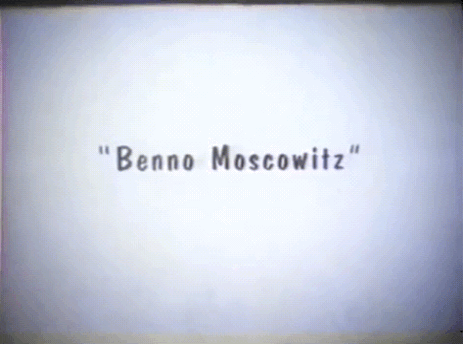
Figure 15: Robert Whitman as Tim Babka, Lucas Samaras as Max Theodopolus, and Jim Dine as Benno Moskowitz.
In the following scenes they proceed to school Williams in the various modes of abstraction. Samaras applies globs of paint to pieces of newsprint splayed out on the floor, and feverishly insists to the protagonist that “sensuous forms are the only ones to consider.” Whitman constructs a precariously hanging assemblage that almost hits Williams as it spins haphazardly around the room. Dine dips his hands directly into a can of white paint and uses his fingers as a brush. Maintaining a straight face, he reaches his paint-covered hand out towards Williams to say, “the tactile element in my work is wonderful.” Kronick stated that all the works featured on screen were made by the cast — although he did not recall what happened to these pieces after the end of the production, or if the artists considered these objects as a part of their oeuvre.
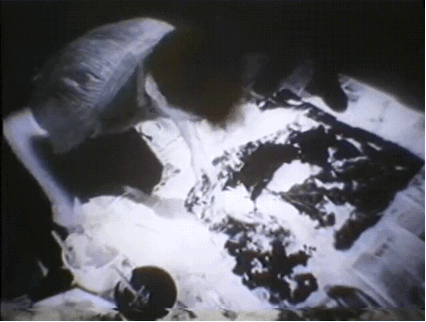
Figure 16: Sherman Williams gets a lesson in abstraction.
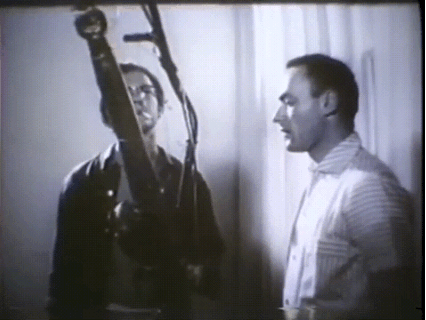
Figure 17: Sherman Williams gets a lesson in abstraction.
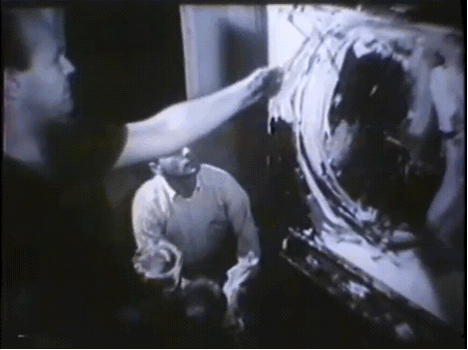
Figure 18: Sherman Williams gets a lesson in abstraction.
The idea of “performing” the artistic process for the camera is integral to discourse of action painting. Photojournalist Hans Namuth has been credited with with transforming Jackson Pollock “From a talented, cranky loner into the first media-driven superstar of American contemporary art, the jeans-clad, chain-smoking poster boy of abstract expressionism” through the medium of photography.[6] His widely circulated images of the artist at work depart from the long-standing convention of picturing the artist sitting stoically behind an easel.

figure 19: Jackson Pollock, by Hans Namuth, 1950.
Dine, in particular, was a voracious consumer of such heroic images of artists, stating in 1977: “As a college student, I schooled myself totally in the New York School, via ARTnews. I remember stealing bound volumes of ARTnews from the ’50s, tearing out pictures, and looking at de Kooning, Pollock, Kline, and everyone else from that period. I knew about everybody. It was an impressionable time for me. I was teaching myself about New York — the moves.” In his recollection Dine evokes something of the performative nature of these images (“the moves”) and suggests the importance of mediated images to his burgeoning art practice.
The Smiling Workman, one of Dine’s most important Painter’s Theater performances, is directly engaged with the legacy of Jackson Pollock. For this piece, Dine created then destroyed an abstract painting in front of a live audience, recreating a spectatorial experience in dialogue with Namuth’s photographs. The artist also decorated the set with white handprints, evocative of those left on Pollock’s canvases as traces of the artistic process.
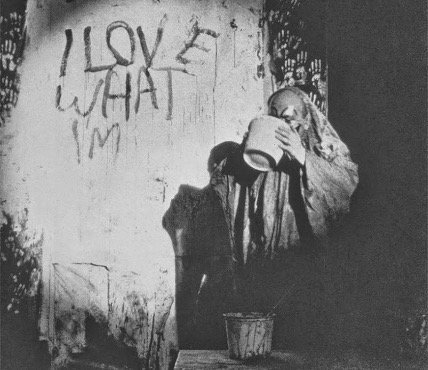
Figure 20: Jim Dine in The Smiling Workman, photo by Martha Holmes, May 1960; Detail of Number 1A, by Jackson Pollock, 1948.

Figure 21: Jim Dine in The Smiling Workman, photo by Martha Holmes, May 1960; Detail of Number 1A, by Jackson Pollock, 1948.
Filmed six months after The Smiling Workman, Dine’s vignette in A Bowl of Cherries recreates aspects of this earlier work for the film camera. As in the performance, Dine presses his paint-covered hands into the canvas to show the protagonist an alternate mode of painterly expression, rooted in physical comedy.
After meeting with Dine, Williams soon becomes possessed with an almost manic drive to create new work. Wearing nothing but a pair of underwear and a bandana around his neck, Williams compulsively applies paint to both the canvas and his studio wall. He becomes so preoccupied with his work that he eventually loses his life savings and can only afford to feed his pregnant wife oatmeal.
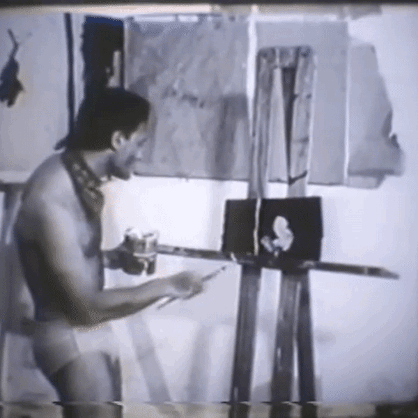
figure 22: Sherman Williams tries abstraction.
As in A Bowl of Cherries, the danger of artistic obsession is also the subject of The Smiling Workman. Filmmaker Stan VanDerBeek shot a version of The Smiling Workman staged specifically for video (versus live performance). Not unlike A Bowl of Cherries, the film rendition of The Smiling Workman is a silent short — sped up to exaggerate Dine’s frenetic motion across the set. Overcome by mania, the artist hastily scrawls the words “I love what I’m doing” onto a piece of paper, before proceeding to pour a can of paint on his head and crash through the canvas.
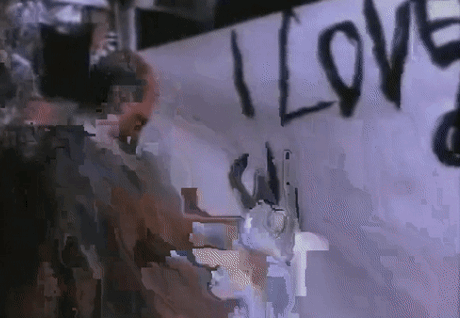
Figure 23: Jim Dine in The Smiling Workman, film by Stan VanDerBeak, 1960.
Whereas Dine punches through the painting at the end of The Smiling Workman, A Bowl of Cherries concludes with Dine visiting Williams in his studio, only to slip and fall onto the cowboy’s unfinished canvas. His physical commitment to the scene is striking and demonstrates the artist’s interest in over-the-top slapstick comedy as a destabilizing force. Dine once remarked, “I do not think Smiling Workman was funny. I do not think obsession is funny or not being able to stop one’s intensity is funny.”[7] Despite the artist’s insistence that the performance was not intended to be comedic, he is nevertheless dressed as a clown.
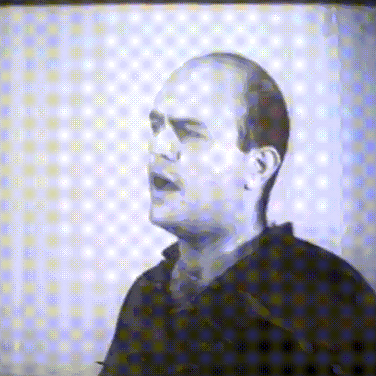
Figure 24: Jim Dine falling onto Sherman Williams’s canvas.
In the early part of his career, Dine repeatedly played with different figurations of the clown character. For example, in The Big Laugh (a happening orchestrated by Allan Kaprow in which actors laughed at the audience for seven straight minutes), Dine played a carnival barker, donning white face paint and a straw hat. In Vaudeville Collage, staged at the Reuben Gallery on June 11, 1960, the artist created his approximation of a cabaret show. Appearing once again in clown makeup as the show’s MC, Dine attached vegetables to pieces of string and made them “dance” around the stage like marionette dolls. Dine was even known to attend gallery openings dressed up in a clown costume, blurring the boundary between life and art.
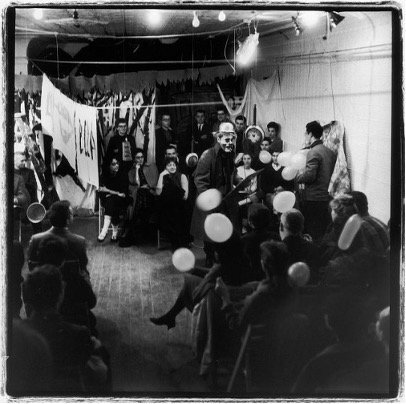
Figure 25: Jim Dine (in hat) in The Big Laugh, by Allan Kaprow, 1960.

Figure 26: Vaudeville Collage, June 11, 1960.

Figure 27: Jim Dine in clown makeup at gallery opening, c. 1960.

Figure 28: Jim Dine in clown makeup at gallery opening, c. 1960.
Discussing his creative partnership with Robert Whitman, Dine stated: “Because we had little children, we watched children's TV in the late '50s and early '60s and that said something about the kind of performances we made. We would refer to Captain Kangaroo…We listened to his way of speaking and the way the characters spoke. It put the performances out of the realm of literal theater by these characters for children speaking to them in this odd way, which wasn't naturalistic.”[8]

Figure 29: Bob Keeshan as Captain Kangaroo (L) and Clarabell the Clown (R).
Again, I find Dine’s reference to mass-media visuals incredibly fascinating. In performances such as Car Crash (1960), the artist did not act on a stage, but wandered freely through the audience — often pushing conventional boundaries of personal space. Although the painter scoffed at the suggestion that he was “the one who did the funny happenings,” laughter was an inevitable component of his outrageous and often uncomfortable performances. A photograph by Fred McDarrah, shows one such instance, in which critic Jill Johnson is pictured with her head tipped back in laughter as Dine (dressed in a Pierrot-inspired getup) lets out a guttural scream.

Figure 30: Jim Dine in Car Crash, November 1960. Photograph by Fred McDarrah.
What then, can we make of Dine’s purposefully comedic turn in A Bowl of Cherries? And how does the technology of film amplify the comedy that characterizes of Painter’s Theater?
To some extent, A Bowl of Cherries provided a space for Dine to act out (or perhaps become) the film sequences that inspired Painter’s Theater. Dine’s performance is filtered through the logic of silent comedy, which results in something quite different (and much tamer) than his Painter’s Theater performances. While he doesn’t wear a literal clown mask, the artist nonetheless plays a fool — and even ends up with a paint-covered face after taking a pratfall on screen.
While it is tempting to over-read A Bowl of Cherries as a “lost” work of Painter’s Theater, the participating artists had very little control over the end product. The filming of A Bowl of Cherries coincided with a period of financial instability for Dine; in August 1960, evidenced by a postcard the artist wrote a postcard to the dealer Allan Karp thanking him for sending a check.

Figure 31: Postcard from Jim Dine to Ivan Karp, c. August 1960. Ivan C. Karp papers and OK Harris Works of Art gallery records, 1960-2014, Archives of American Art.
While Kronick couldn’t tell me what kind of compensation Dine received for his performance in A Bowl of Cherries, the film shoot occurred in between two of his major performances (Vaudeville Collage, June 11, 1960, and Car Crash, November 1-6, 1960) indicating that the artist undertook the project during a short hiatus, perhaps just as a fun way to make some extra money.
Kronick lost touch with the cast shortly after filming wrapped at the end of September 1960. Although A Bowl of Cherries was accessioned into MoMA’s film collection shortly after its release, the short featurette has rarely been reshown and has virtually no presence in art historical literature. Nor is it cited in any of Dine’s numerous career-spanning monographs, despite the many connections with other works in his oeuvre.
A Bowl of Cherries offers an unexpected point of entry into Painter’s Theater and its relation to film.. This short featurette is a curious work at the crossroads of avant garde and popular culture and nicely captures the transition from painterly post-war art culture to the performative art culture that comes to dominate in the 1960s.
[1] Artist statement printed in Mekas, “New York Letter: Towards a Spontaneous Cinema,” 120.
[2] Artist statement printed in Mekas, “New York Letter: Towards a Spontaneous Cinema,” 120.
[3] Alfred Leslie "Pull My Daisy: Ten Years Later, Village Voice, November 28, 1968, 54.
[4] See William Glover (AP), “Experimenting Film Director Swings Back into 'Silent'," The Amarillo Globe-Times, March 16, 1961, 20
[5] Courtesy Vivian Springford Estate, Almine Rech Gallery, New York, NY. See also Phong Bui, ed., Vivian Springford (Brusssles, BE: Almine Rech Editions, 2018).
[6] Ferdinand Protzman, “The Photographer's Snap Judgment,” Washinton Post, May 23, 1999. https://www.washingtonpost.com/archive/lifestyle/style/1999/05/23/the-photographers-snap-judgment/7062b20f-a479-4dad-af27-c1144896e6bb/
[7] Statement quoted in Michael Kirby, Happenings: An Illustrated Anthology (New York: EP Dutton, 1965), 186.
[8] "Walking Memory: A Conversation with Jim Dine, Clare Bell and Germano Celant," 63.
BiographyRose Bishop is a PhD student in the Department of Art History at the University of Southern California and an enrollee in the Visual Studies Research Institute (VSRI). She received her master’s degree in Art History and Curatorial Studies from Hunter College in 2021. Her scholarship focuses on the history of photography and mass media in the United States, with an emphasis on celebrity culture and fashion. Bishop is also a 2022-23 National Endowment for the Humanities Graduate Fellow with the VSRI’s Images Out of Time seminar, an interdisciplinary workshop that considers how images travel through time, dropping in and out of linear histories and reshaping perception, institutions, and social practices along the way.
Her article, “‘The Whole Show on One Photograph’: Gordon Anderson and the Making of a Star at Harlem’s Apollo Theater,” will be published in the Spring 2023 issue of Transbordeur and represents the first in-depth exploration of the photographer’s prolific career as a concert documentarian. Bishop has also contributed writing for 125th Street: Photography in Harlem (Hirmer Publishers with Hunter East Harlem Gallery, 2022) and What They Saw: Historical Photobooks by Women, 1843–1999 (10x10 Photobooks, 2021), which received the Paris Photo–Aperture Foundation Catalogue of the Year Award in 2021.
Prior to her academic career, she worked as an archivist at the Richard Avedon Foundation.
March 22, 2023
We Witnessed One of the Best FIFA World Cups Ever Played on the Graves of Thousands of Migrant Workers… What Now?
The following post was created as part of the assigned work for Henry Jenkins's PhD seminar, Public Intellectuals. The goal of the class is to help communication and media studies students to develop the skills and conceptual framework necessary to do more public-facing work. They learn how to write op-eds, blog posts, interviews, podcasts, and dialogic writing and consider examples of contemporary and historic public intellectuals from around the world. The definition of public intellectuals goes beyond a celebrity-focus approach to think about all of the work which gets done to engage publics -- at all scales -- with scholarship and critiques concerning the media, politics, and everyday life. Our assumption is that most scholars and many nonscholars do work which informs the public sphere, whether it is speaking on national television or to a local PTA meeting.
On December 18, 2022, approximately one out of every five human beings on Earth watched Lionel Messi lift the World Cup for Argentina in Qatar. What seemed like the pinnacle of everything sports, culture, politics, entertainment, and humanity was reached when Gonzalo Montiel neatly tucked in that 4th Argentina penalty to the right of French captain and goalkeeper, Hugo Lloris. What still replays in my mind, as well for millions of others, is iconic Argentinian American sports commentator, Andres Cantor, calling the game live in Spanish for Telemundo as that final penalty went in, “GOOOOOOLLLLLLLL! ARGENTINA CAMPEÓN DEL MUNDO! ARGENTINA CAMPEÓN DEL MUNDO!” as he smiled and cried on live air.
Andrés Cantor, who moved to the U.S. from Buenos Aires as a teenager, calls Argentina winning the World Cup: pic.twitter.com/4PougSj1g7
— luffy (@vvsLuffy) December 18, 2022
Now rewind 12 years to December 2, 2010, when FIFA announced a shock when Qatar - a small Arab Gulf nation that wasn’t too well known on the world stage and had almost no football/soccer history - was awarded the bid for the 2022 FIFA Men’s World Cup, beating out the likes of England and the United States. FIFA’s decision clearly set off alarms concerning suspicions of corruption and bribery. Out of the eight stadiums that were to host World Cup matches, seven of them were not even built yet. The country was in no shape to host the largest sporting event in the world, and so a 12-year rapid growth project ensued.

Laurence Griffiths/Getty Images
Quickly, it became clear that this project was fueled by migrant laborers (mostly from South Asia) under a strict labor system called the Kafala. Pete Pattison came out with a groundbreaking exposé on how Qatar was essentially operating under labor conditions that many referred to as modern day slavery. Migrant workers in extremely economically precarious situations were essentially exported by contracting agencies in their home countries under misleading employment terms and (in many cases) worked to death. Nepali migrant workers made up a disproportionately high number of Qatar’s workforce in the last decade, listed as the second most populous group in the country (even ahead of Qatari nationals). The majority of Qatar’s population is composed of migrant workers, with most of them coming from South Asian countries.
While the exact number is disputed, over 6,500 workers were killed by the time the kickoff whistle blew for the opening Qatar vs. Ecuador match. Many people were aware of these conditions around this 2022 FIFA World Cup, yet so many didn’t know what to do about it. Ultimately over $200 billion was spent with an estimated revenue of only around $10 billion. Certain Western countries such as Denmark and Germany tried to engage in subtle and non-disruptive protests such as posing in the starting XI lineup with their mouths covered, yet drew backlash as the team and federation turned a blind eye when German star Mesut Ozil spoke about the racism he experienced for his Muslim faith and Turkish background. A number of European captains planned to wear rainbow-colored armbands as a protest to the anti-Gay laws in Qatar, but swiftly backed out when FIFA officials threatened them with yellow cards as punishment.

Alexander Hassenstein/Getty Images
When asked about the number of deaths, Qatari officials acknowledged that there were three deaths in the buildup to the World Cup, but eventually said there were between 400-500 when pressed further, which is a still a gross underestimate of the lives of migrant workers lost in Qatar.
As part of my undergraduate thesis, I travelled to Nepal to conduct ethnographic work and interviews with these migrant workers who were in the process of obtaining visas for migrant labor to Gulf Countries and those who had returned from working in these places. As if reading about all these atrocities and watching several expose documentaries was not disheartening enough, talking to these people who were vulnerable (and in many ways manipulated), I felt like I wanted to do something about it besides studying what was really going on behind the scenes. Awareness doesn’t do too much when you’re dealing with arguably the single largest collectively shared, simultaneous human experience - the FIFA World Cup with its hundreds of billions of dollars in capital investment.
I found that the operation of migrant labor for these types of global mega-events were rooted much deeper than they seem. Especially in economies that were vulnerable and malleable, the geopolitics of exporting labor were a significant portion of ensuring a growing economy at the cost of the lives of those at the bottom of the socio-economic hierarchy. Approximately 1/3 of Nepal’s GDP is remittances - money that gets sent back home by Nepali workers abroad. This meant that the hundreds of thousands of workers going abroad (and thousands of them dying) were not a coincidence but part of an oiled machine. Airlines, healthcare companies, banks, and a number of other industries all relied on the exportation of migrant workers to operate and make a profit. Returning from my travels at the Kathmandu airport, I really got a glimpse of how important the labor exportation economy was. There were three designated lines at the exit visa area: 1. Nepali nationals, 2. Foreign Nationals, 3. Migrant workers. I had never seen that third designation at any airport I had been to; to put in perspective, that migrant worker line was by far the longest line whereas the other two were practically empty.

Picture by Pratik Nyaupane
The profit, however, meant that these workers (mostly young men from impoverished families and very low education and literacy rates) would arrive in foreign countries such as Qatar to have their passports confiscated, pay withheld, and forced to live and work in unsafe and unsanitary conditions. As I talked to many of these workers, they were simply trapped in this inhumane operation, not just by their employers, but by the governments and agencies designated to support them.

Sam Tarling/Corbis via Getty Images
But there is also no denying that to many like me, the FIFA World Cup is the ultimate form of emotion, family, and connection. I spent hours each day watching every minute of every match for a month. My phone was blowing up with notifications in the half a dozen group chats I was in alongside several other friends who were texting me about every goal, controversial play, and nail-biting moment. Almost everyone who has watched soccer in the last 30 years has grown up watching Lionel Messi play and cementing his stature as one of the greatest athletes to have lived, winning every trophy eligible besides the most difficult one of them all - the World Cup. I found myself singing Argentinian chants while standing in line at the store while witnessing videos of hundreds of thousands of people in every corner of the world, such as those in Bangladesh (a country that also exported thousands of laborers to Qatar), stay up until 4 am to watch Argentina’s historic run.
Embed Block Add an embed URL or code. Learn moreArgentina fans in Bangladesh as Argentina won the World Cup. Via @robiulhossainn. pic.twitter.com/U980TLiagi
— Roy Nemer (@RoyNemer) December 19, 2022
For every soccer fan and Argentinian, this World Cup will be a moment they will never forget. Millions of people in Buenos Aires flocked to the streets at the same time as thousands filled Times Square and other town squares across the world to celebrate. My grandmother in Nepal told me she couldn’t sleep because people were shooting off fireworks all night with excitement over Argentina’s first world cup victory in 36 years. Clearly the passion of the sport of world football takes over the world. , whether it be watching a match or engaging with social media content.
It has now been over two months since the World Cup ended, and we are forced to ask the question: were those moments of joy worth the thousands of deaths of workers and the abuse and trauma of hundreds of thousands more? Obviously, not.
The geopolitical and economic power of sporting governing institutions such as FIFA and the International Olympic Committee are expanding more and more. I argue that these are full governmental bodies themselves and harness enough power to override the sovereignty of many nations and human rights of billions. It has been evident that with the joy surrounding football can be used for good, however these organizations are able to act recklessly without oversight and accountability for their own profit and power.
The FIFA Women’s World Cup is less than 150 days away, and the next men’s tournament is being hosted in the US, Canada, and Mexico in 2026. I do believe that sports can be enjoyed by the masses without there being violent harm, displacement, labor exploitation, and death, but the playing field is uneven with institutional and political power on the sides of those who merely seek profit. I don’t know the simple answer. But what I do know is that there are already a number of human rights, labor rights, migrant rights, and other advocacy groups that have been relentlessly fighting against the harm that these events cause. Now, it really is abilities as individuals to engage through collective action to hold officials and bad actors (who are greenlighting these detrimental operations) accountable to ensure that that we can prevent these grave injustices from occurring in the future.
BiographyPratik Nyaupane is a doctoral student at USC Annenberg, where he focuses on research broadly relating to technology, inequality, and social and political movements. As an early career scholar, his work explores how various groups utilize and perceive technology as a means of political power. His recent projects consist of studying surveillance capitalism on university campuses and researching environmental justice groups’ utilization of technical practice and citizen science initiatives. His work is grounded in the needs and concerns of communities that are subject to systems of oppression. Prior to joining USC, he graduated from Arizona State University summa cum laude with a B.S. in Informatics and a minor in Political Science.
How Omegaverse Came to Dominate Fanfiction, and Why That Might Not Be Such a Bad Thing
The following post was created as part of the assigned work for Henry Jenkins's PhD seminar, Public Intellectuals. The goal of the class is to help communication and media studies students to develop the skills and conceptual framework necessary to do more public-facing work. They learn how to write op-eds, blog posts, interviews, podcasts, and dialogic writing and consider examples of contemporary and historic public intellectuals from around the world. The definition of public intellectuals goes beyond a celebrity-focus approach to think about all of the work which gets done to engage publics -- at all scales -- with scholarship and critiques concerning the media, politics, and everyday life. Our assumption is that most scholars and many nonscholars do work which informs the public sphere, whether it is speaking on national television or to a local PTA meeting.
Header image attribution https://foto.wuestenigel.com/women-writing-on-paper/
One of my favorite things to explain to strangers at parties is the omegaverse. More often than not, young women and gender non-conforming people hear that title and immediately burst out in laughter; they already know what I’m talking about and are excited to see someone react for the first time to one of the oddest—but somehow incredibly popular—phenomena on the internet.
At parties, I explain omegaverse in hyperbole. I say, “Okay, it’s a world where everyone is either an alpha, beta, or omega. Alphas have massive penises that knot—yes, like a dog,” I pause here while my audience laughs, “and omegas can get pregnant. Anatomy varies, sometimes they’re intersex, sometimes they just have vaginas, and sometimes they can get pregnant through their ass? I guess?” I pause here again for all the delighted, fascinated questions (Wikipedia has a helpful chart explaining some common anatomy configurations—see Figure 1). “But they always have some form of self-lubrication; that’s called slick. No, I’m serious! People love this shit!”
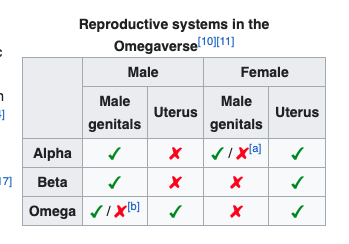
figure 1
And then, I pull up Archive of Our Own and show them this.

figure 2
There are over 165,000 pieces of literature in this universe—that’s 10,000 more than there were when I wrote my first draft of this post, only two weeks ago. Then, I open TikTok. TikTok has banned the tag #omegaverse, but it’s still widely discussed in my corner of the app. @icaruspendragon has even made a social media career off of explaining the nuances of omegaverse to her 315,000 followers.
This post, simply explaining how the aforementioned knot works, has over two million views. The omegaverse has started to leave the more close-knit and insular spaces of fanfiction and entered romance publishing; even The New York Times wrote about one author’s attempt to copyright omegaverse, and Lindsay Ellis’s video essay on the same topic has already racked up over 3.5 million views.
Omegaverse may not be hitting the mainstream any time soon, but awareness of the trope is no longer limited to the few—or not so few—actively engaging in fanfiction communities. However, as I and all the people laughing with me know, omegaverse is weird, but it has a lot more nuance than I can generally explain at parties, as well as a long history in fandom.
The first official stories using omegaverse terminology popped up in the early 2010s in the fandom adjacent to the TV show Supernatural, except they focused on the actors, not the characters. Jensen Ackles was the first omega, and Jared Padalecki was the first alpha. Some of the tropes that are common in omegaverse go back further, too. Star Trek’s concept of the Vulcan mating cycle, pon farr, lines up well with the omegaverse idea of heat, and fans have been finding ways to get men pregnant in their fanfiction since at least 1988.
@oldmythos I love that I had to get access to a university archive to read this AND I DID #PepsiApplePieChallenge #fic #ao3 #omegaverse #mpreg #history ♬ Lofi - Domknowz
But that’s just the problem with omegaverse for a lot of people: it almost always focuses on men. 84% of the omegaverse fanfiction on Archive of Our Own is tagged M/M, or slash, meaning it focuses on the relationship between two men. Except, in this universe, one of them can also get pregnant. In the early discourse around omegaverse within fandom, this trope was pretty widely seen as a bad thing. I remember reading through conversations on LiveJournal where fans I looked up to talked about how misogynistic it was, how it removed women from the universe. Fathallah (2017) quotes a fan’s comment on an omegaverse fic: “‘I love these AU’s where women seem to die off or don’t exist and men can have babies,’” (p. 73). Omegaverse is also often based in incredibly patriarchal systems in which alphas literally and biologically own omegas; rape and dubious consent are also common to the trope. In place of women, omegas—again, often omega men—become the victims of gendered violence and all forms of oppression. To quote one of my students, “it just recreates heteronormativity and misogyny, but more and worse.” This just begs the question: what makes omegaverse so popular, and should we be worried about it?
Fans in 2023 have had over a decade to hone their criticisms of the practice, even as it has grown. The problem is no longer just misogyny but transphobia as well. Fans argue that omegaverse writers have created an entirely new universe to avoid writing about transgender men, who can get pregnant in this universe, the one we live in. It creates a new type of gender essentialism; in omegaverse, sexes are signaled not only by appearance and genitalia but by unescapable scents. An important caveat here: male omegas are still men in omegaverse. They are almost always addressed with he/him pronouns, and if they do in fact bear children, they are often still called “father.” Omegaverse allows for a separation of sex and gender, in which reproductive organs don’t necessarily determine if you are a man or a woman or any other gender. Reproductive organs do, however, determine social and hierarchical statuses in these invented societies.
All of this is true, and they are all valid criticisms. Why then, does it remain so popular amongst fans, who are often queer women and gender non-conforming people? We don’t want to live in a world where our gender identities are re-prescribed in new ways, and we don’t want to live with the constant threat of sexual violence like omegas often do in our fanfictions.
Popova’s (2021) article “Dogfuck Rapeworld” (title referencing a self-satirizing meme fans use to talk about omegaverse) argues that the writers, often women, create power imbalances in order to explore them and warp traditional sexual scripts. In her construction, it creates a new layer of intimacy that exists for the sake of romance and kink. It becomes a space of exploration for intimate and sexual desire, one that removes the potentially triggering reality of sexual violence on women’s bodies.
Fans use omegaverse to explore the deepest violence of cis-hetero-patriarchy through non-real, alien, invented anatomies; not just the kinks. Kelsey Entrikin has a fantastic dissertation on the subject through the queer lens, but I first came to this realization as a long time, avid reader and writer of the trope. In omegaverse, omegas live in the most oppressively gendered society imaginable. They’re often not allowed to work, kept as sexual slaves, and bound by heat cycles that periodically make their lives miserable. They’re sometimes dramatically smaller than alphas and have overwhelming weaknesses to things like an alpha’s scent or command. And yet, omegas survive and find ways to work the system.
Sometimes, omegas work their way through society by hiding their status. Sometimes, they kill their captors and escape sexual slavery. Sometimes, omegas create intimate and sexual relationships with other omegas in order to keep themselves safe from alphas. In my own fanfiction, I’m interested in how omegaverse functions under capitalism, how labor and wage inequalities might be rectified in a world that is even harsher than our own.
Dystopian science fiction can take us to the worst edge of the current world and ask what if? Sometimes it’s through a climate apocalypse, or a nuclear disaster, or after a collapse of capitalism, but these ideas all explore the looming problems of real life. In omegaverse, writers take us right to the worst parts of cis-hetero-patriarchy; they reject the world we live in in order to explore the complications of sex, gender, and sexuality more deeply. They ask what if? in a way that allows not only complex looks at how things like reproductive rights function but also indulgence and enjoyment. Right next to a rant about inequality, there is full on erotica.
Omegaverse plays with some of the most problematic facets of gender and sex. Returning to my wise student’s words, omegaverse “recreates heteronormativity and misogyny, but more and worse”; but that’s the point. It turns up the dials on problems that deserve attention, and fans use that to say something, even if they don’t know what they have to say yet.
When I explain omegaverse to strangers at a party, I don’t tell them about the nuanced representations of gender and power; that’s not what makes people read a work of literature, at least not if they’re reading for fun. Even so, omegaverse makes those arguments. People can read for indulgence and come out hyper-aware of facets of society they might not have been paying attention to. Radicalization and joy are a powerful combination (even if they came together through wolf porn).\
BiographyYvonne Gonzales is a PhD student at the USC Annenberg School for Communication and Journalism, where she studies fan culture and transformative fiction. She earned her bachelor's degree in English at UC Berkeley. Her research focuses on the connections between fan subcultures and the larger patterns of culture that create and maintain fandoms.
March 20, 2023
Elder Orphans: A Hard Knock Life?
The following post was created as part of the assigned work for Henry Jenkins's PhD seminar, Public Intellectuals. The goal of the class is to help communication and media studies students to develop the skills and conceptual framework necessary to do more public-facing work. They learn how to write op-eds, blog posts, interviews, podcasts, and dialogic writing and consider examples of contemporary and historic public intellectuals from around the world. The definition of public intellectuals goes beyond a celebrity-focus approach to think about all of the work which gets done to engage publics -- at all scales -- with scholarship and critiques concerning the media, politics, and everyday life. Our assumption is that most scholars and many nonscholars do work which informs the public sphere, whether it is speaking on national television or to a local PTA meeting.
It’s a hard knock life for us
It’s a hard knock life for us
’Stead of treated
We get tricked
’Stead of kisses
We get kicked
It’s the hard-knock life
After the world went nuts over Jay-Z’s 1998 hit single, “Hard Knock Life (Ghetto Anthem),” Charles Strouse, the composer of the original song from the musical Annie that Jay-Z sampled, was asked for his reaction to it. Aside from being a little worried about all the “swears” and use of the “N-word,” the Broadway veteran liked it and said, “In some areas, there's parallel thinking between me and Jay-Z...'Hard Knock Life' had to reflect the fact that the kids in the story were underprivileged and exploited."
Jay-Z didn’t share Strouse’s point of view about the grubby band of orphans singing about their sorry lot in life, saying, “They ain't singing that song as if they sad about it. 'Ok, this is our situation. We gonna make the best of it,’ and went on to say:
“You know, I knew how people in the ghetto would relate to words like, 'Instead of treated we get tricked' and 'Instead of kisses we get kicked'…It's like when we watch movies we're always rooting for the villain or the underdog because that's who we feel we are. It's us against society. And, to me, the way the kids in the chorus are singing 'It's a hard-knock life' is more like they're rejoicing about it. Like they're too strong to let it bring them down. And so that's also the reason why I call it the 'Ghetto Anthem."
You can watch “It’s a Hard Knock Life” from the original 1982 film version with Carol Burnett and Albert Finney above, or you can watch the later 2014 version with Cameron Diaz and Jamie Foxx (although if you love musical theater, I recommend avoiding the later version like the plague, as you will never be able to unsee Cameron Diaz’s performance as Miss Hannigan).
Where am I going with this, you ask? Well, first of all, Jay-Z’s “Hard Knock Life” is a great song, so if you’ve never heard it, you’re welcome.
Second, I think we can learn from his point of view about the resilience and strength of the underdog when it comes to growing old on one’s own, and on what it means to be an “elder orphan” in America.
Helen Dennis and I wrote about the somewhat unfortunately named “elder orphans” in a book chapter on retirement:
“The term ‘elder orphans’ is referred to in gerontological circles as ‘aged, community-dwelling individuals who are socially and/or physically isolated, without an available known family member or designated surrogate or caregiver.’ An alternative term ‘solo agers’ was recently introduced by author and life planning coach Sarah Zeff Geber. Geriatricians, gerontologists, retirement planners and others concerned about older adults aging alone are focused on the ‘acute’ issues solo agers may face, such as making plans for what would happen should they need legal guardianship or become incapacitated with no one to advocate for them.” (Dennis & Marnfeldt, 2021)
It’s true, growing older without a family support network has the potential to put people in vulnerable situations. A quick Google image search will tell you what the world thinks growing older alone looks like—apparently a lot of looking out the window:

figure 1
The thing is, being a solo ager is not rare and is even becoming the norm. A 2020 survey by the AARP found that 12% of people in the United States over the age of 50 live alone, are un-partnered, and have no living children. Living alone also increases with age, especially for women who have a longer life expectancy, and are typically partnered with someone older than themselves to start with. In a 2021 profile of older Americans published by the Administration for Community Living, 20% of men and 33% of women over the age of 65 lived alone.

figure 2
Profiles of “kinless elders” that often emerge in the press are exemplified in this December 2022 New York Times article, “Who Will Care for ‘Kinless’ Seniors?” by Paula Span. Most coverage of older adults in the mainstream press emphasizes a decline narrative, whether it’s a decline in health, mental capacity, or social capital. A more positive narrative is one of resilience and resourcefulness.
In Span’s article, two kinless older women, Lynne Ingersoll, a 77-year-old retired librarian, and Joan DelFattore, a retired English professor, are featured. Both women arrived kinless in elderhood, one by choice, the other by circumstance.
Ms. Ingersoll didn’t know she was on a path to become an elder orphan. The path only became clear in retrospect as she slowly outlived her parents, her partners, her pals and her pets.
“My social life consists of doctors and store clerks—that’s a joke, but it’s pretty much true,” she says now, as she manages to take care of herself, despite multiple debilitating health conditions.

figure 3
A contrasting profile to Ms. Ingersoll’s is one of Joan DelFattore, a woman who deliberately fashioned her life to become an elder orphan. She said she knew from a young age that she didn’t want to be a wife or a mom, and she knew she preferred living alone. With that, she says she “went about constructing a single life.” The retired professor is healthy, still engaged in her work as a researcher and teacher, and has a wide circle of both personal and professional social connections.

figure 4
Ms. Ingersoll would presumably argue that she too “constructed” her life based on her preferences as a younger woman the same way Prof. DelFattore did. She didn’t want to live alone, and yet she does. She had no children, but she had three life partners over the years who all predeceased her.
She’s living the hard knock life of an elder orphan in her later years due to many things out of her control. She can take care of herself now, but in a year or two or five, who knows? Where will she live, and will she be able to make that choice for herself?
In 2016, a survey of an Elder Orphans Facebook group was conducted among over 500 of its 10,000+ members aged 55+. It found that 45% of its members had lived alone for 20 years or more, with 42% saying they lived alone just because they wanted to.
In a section of the survey on vulnerability, respondents were asked if they believed they could take care of themselves as they aged. Answers were pretty equally distributed across three buckets—those who said definitely yes (28%), those who said probably yes (35%), and those who were hedging a bit with “maybe/maybe not” (33%).
Asked about their top choice for where they want to live as they age, it comes as no surprise to those of us in the field of aging and gerontology that almost 50% of the Facebook elder orphans say their wish is to remain in their own home, with another almost 30% adding a more detailed version of that, saying they want to live in a “Tiny affordable house in a village of people like you.”

figure 5
Only 2% said their top choice was to move in with another family member, and just 1% said they wanted to rent a room in a home they shared with someone else. A surprising 12% said they’d choose “affordable” assisted living.
I say surprising because they keep using that word—“affordable”—and I do not think it means what they think it means because there is virtually no “affordable” assisted living in the United States, unless you have a minimum of $3,000 bucks a month to spare and want to live in one of the Dakotas.
And yet, I get it.
Keeping the “affordable assisted living” myth alive is far better than contemplating a terrifying possible future where a kinless elder might have no alternative but to be placed in the modern day equivalent of an orphanage for older people—a nursing home.
It’s not a stretch to think that older adults are more freaked out than usual about the possibility of being placed in a nursing home, given what we’ve lived through over the last three years. From the start of the COVID-19 pandemic through January 2022, over 200,000 residents and staff in nursing facilities in the U.S. died, and the death rate for people living in nursing homes was more than 23 times the death rate of people over age 65 who did not live in nursing homes.
Two hundred thousand people dead. What’s an elder orphan to make of that?
Maybe, like Jay-Z, elder orphans have metaphorically revised the “Hard Knock Life” lyrics in their heads?
It’s a hard knock life for us
It’s a hard knock life for us
No one cares for you, a smidge
When you’re in an orphanage
That’s probably too optimistic for most budding elder orphans or other reality-based individuals. They probably think more like Tracey Pompey. Ms. Pompey, a nurse’s aid for 30 years who believes she lost her father due to neglect in a nursing facility, said:
People get desensitized to things like this…
If it happens to a child or a dog, people won’t shut up.

figure 6
The people in the elder orphans Facebook group are probably more aligned with Ms. Pompey’s sentiments, as they understand the risk of the social (and literal) death they face being orphaned in late life.
I wonder if their mindset is less Jay-Z and more Killer Mike in the 2017 “Hummels & Heroin” episode of South Park, where he voiced the original song, "They Got Me Locked Up In Here.”
The episode is a parody of the opioid epidemic set against the nursing-home-as-prison paradigm that was as salient in 2017 as it is today and probably will be in 2050. The first stanza ends with nursing home placement as indictment:
🎶 They got me locked up in here
They got me locked up in here
And I’m sitting, doin’ hard time
Pissin’ in a metal bowl
Eatin’ shit from a lunch line
(They got me locked up)
In here, nobody knows you by your name
You just a number
Livin’ under bitch-ass rules of a broken game
They put me here to die,
Left me angry and alone
For the crime of being old
They threw me in this nursing home
Jay-Z’s “Hard Knock Life” from 25 years ago was about rooting for the orphan kid, the underdog, in an “us against the world” vibe that felt at once cautious but hopeful. Killer Mike’s rendition of the orphaned elder is decidedly more dark and hopeless but also reflective of what many people believe to be true.
Contemplating this harsh reality made me reach for Jay-Z again and his 2009 single, “Young Forever” from the “Blueprint 3” album, in which his optimism is unfettered by caution:
🎶So we live a life like a video
When the sun is always out and you never get old
And the champagne’s always cold
And the music is always good
And the pretty girls just happened to stop by in the hood
And they hop their pretty ass up on the hood of that pretty ass car
Without a wrinkle in today
’Cause there is no tomorrow
Just some picture perfect day
To last a whole lifetime
And it never ends
’Cause all we have to do is hit rewind
So let’s just stay in the moment
Smoke some weed, drink some wine
Reminisce, talk some shit, forever young is in your mind
Leave a mark that can’t erase, neither space nor time
So when the director yells cut we’ll be fine
Ah Forever young
Sometimes we need to cling to “forever young” in our minds to escape from hummels and heroine, but, most days, it’s just a hard knock life for us.
Biography
Kelly Marnfeldt is a doctoral candidate at USC’s Leonard Davis School of Gerontology, where she also received her Master of Science in 2019. Her research interests broadly include the impact of caregiver burden, the meaning of justice for victims of elder abuse, and the intersection of vulnerability and autonomy for people living with dementia who wish to age in place in their communities.
March 17, 2023
A Glimpse into the Brain-Bending Way We Appraise Health Information
The following post was created as part of the assigned work for Henry Jenkins's PhD seminar, Public Intellectuals. The goal of the class is to help communication and media studies students to develop the skills and conceptual framework necessary to do more public-facing work. They learn how to write op-eds, blog posts, interviews, podcasts, and dialogic writing and consider examples of contemporary and historic public intellectuals from around the world. The definition of public intellectuals goes beyond a celebrity-focus approach to think about all of the work which gets done to engage publics -- at all scales -- with scholarship and critiques concerning the media, politics, and everyday life. Our assumption is that most scholars and many nonscholars do work which informs the public sphere, whether it is speaking on national television or to a local PTA meeting.
Since the early days of newspaper printing in the United States, mass media and public health scholars have observed spikes in the prevalence of mis/disinformation related to major public health advancements, including the discovery of immunizations, the introduction of water fluoridation, and the implementation of tobacco regulations. While the problem of mis/disinformation is not new, the advent of social media has magnified the reach and impact of unverified and harmful health information. The cost has never been more visible than it is today, amid a global pandemic that has claimed more than 6.5 million lives, disproportionately affected communities of color, and erased decades of women’s progress in the labor market.
Despite the toll of the COVID-19 pandemic, vaccine hesitancy remains a significant public health challenge, and it’s only one of many health arenas plagued by uninformed or misinformed decision-making. To make sense of it, let’s begin with some of the sources that produce mis/disinformation, putting aside for a moment the personal and cognitive attributes that make someone susceptible to fake news/conspiratorial thinking.
Increasingly, junk science is being introduced through various digital media sources. One recent study found that 36% of U.S. adults cited the internet as their most common source of health information (roughly half cited their health professional, and a third cited television). Alternative medicine websites, such as NaturalNews.com, serve as examples of online worlds that promote false and misleading claims to millions of users through a network of 200+ interlinked websites, such as VaccineHolocaust.org and Healthfreedom.news. In more sophisticated cases, peddlers of false health information employ a common yet insidious tactic – embedding a kernel of truth within layers of spurious claims. The single piece of truth serves to lend credibility to a series of unfounded connections.
Take, for example, the Brownstone Institute, which positions itself as a nonprofit “think tank” staffed with credentialed academics and physicians. In one recent Brownstone article called “Have the Children Been Poisoned?” the article’s author claims that the use of masks and hand sanitizer lead to toxic poisoning of children (spoiler: this is not true). Upon further evaluation, more skeptical readers will find that the Brownstone Institute is a special interest group comprising anarcho-capitalist physicians who have been condemned by the U.S. medical establishment and reprimanded by their respective state medical boards.

figure 1
Now let’s return to the question of personal susceptibility: why do some people stop to question the claim that face masks poison children and others don’t? What underlying skills, competencies and biases allow some people to sail past junk science and others to capsize? One piece of the answer is media literacy, or one’s ability to “access, analyze, evaluate, create and participate with messages in a variety of forms” (Center for Media Literacy). In this context, numerous studies examining the relationship between media literacy and health beliefs have consistently shown that low levels of media literacy are linked with greater susceptibility to digital mis/disinformation. There is also a body of evidence that shows an independent linear relationship between low functional literacy (i.e., basic reading and writing skills) in adults and poor health outcomes, including higher rates of hospitalizations and mortality. Translation: If you struggle to understand what your doctor is saying, or you can’t follow the instructions on your prescription bottle, you’re probably less likely to achieve positive health outcomes.
Given these findings, there is ample groundwork to suggest a relationship between the intersection of media and health literacies – referred to here as Media Health Literacy – and health beliefs/outcomes (that is, if you have a high level of MHL, you are more likely to dismiss junk science and less likely to suffer from preventable health issues). But before I could test that hypothesis, I needed a way to measure Media Health Literacy – conceptualized here as how well adults in the U.S. access, produce, identify, critically evaluate and engage with mediated health information. The complete definition shown in Figure 2 is the result of an exploratory research project conducted last year, which also yielded an accompanying checklist of operationalized competencies (for those interested, that list is available here).

figure 2
But what does MHL look like in ‘real life’?It turns out, Media Health Literacy is easy to define but hard to capture. Three weeks ago, I wrapped up a limited set of cognitive interviews with six people who agreed to take a MHL survey while talking out loud about their thoughts and decision-making processes. The survey itself seeks to measure a diverse range of media and health literacy competencies, including critical reasoning, under the umbrella term Media Health Literacy. The “think-aloud” component began as a way to pilot test the survey’s wording and design, but it ultimately revealed something far more interesting: the derailing effect of health-specific stimuli on an otherwise linear cognitive track.
One interviewee in particular (let’s call her Jennifer) provides a helpful illustration of the type of meandering heuristics that surfaced in all six think-aloud interviews. For background, Jennifer is a white woman in her early 40s who lives in Los Angeles, has a high school education, and identifies as Jewish and a Democrat. As part of the think-aloud interview, we spent about an hour going through 20 questions, stopping at each one to discuss and debrief.
Let’s unpack one example related to online source credibility. The question asked Jennifer to evaluate the reliability of two different websites – 1) a brazen junkyard of health mis/disinformation (NaturalNews.com) and 2) an evidence-based website hosted by the National Institutes of Health (MedlinePlus.gov). Surprisingly, Jennifer ranks them as equally unreliable on a scale of 1 to 6. She awarded both websites a “2” for “Unreliable,” even though each source represents dramatically different (and often contradictory) ideologies, presentations, agendas and revenue sources. Here’s how she explained her rankings:
“I would rank ‘NaturalNews’ as 2 (Unreliable), but I would not say ‘Very unreliable’ because someone did take the time to gather all this information so there is some accuracy I imagine. [But] anytime I see anything like this, in this format, it makes me feel like I’m being lied to, or that they’re trying to sell something. For the second one [MedlinePlus.gov], I would say 2, unreliable, again. Because there’s room that there is some truth but I don’t trust it. I feel like there’s Western medicine that I don’t trust completely and it looks like all this information comes from Western medicine. I would say 2 because there’s probably some truth in there but I’m just really skeptical.”

figure 3
Interestingly, when shown a TikTok video that argued against the use of antibacterial soap, Jennifer found the source –immunologist and pharmaceutical scientist Morgan McSweeney, PhD –highly credible even though he presents as highly “Western.” She did not address the contradiction but did explain that seeing the information presented by one person in a video format was much more compelling than reading online articles without a “face” to them. She explained:
“[The video] confirms what I already believe. You know what this video makes me realize?: if those news articles [NaturalNews and MedlinePlus] were done ‘in person’ by someone like that, who sounds like he knows what he’s talking about, I would be more apt to follow it rather than reading it. I need someone to be confident and actually sell it.”
In the previous example, the appearance of “trying to sell something” was cited as a reason not to trust the source; in the most recent example, Jennifer contradicts this reasoning and commends Dr. McSweeney for assuming the role of a confident salesperson. While the medium (text vs video) may be a contributing factor, as she claims, her assessment is also likely influenced by confirmation bias – one’s natural inclination to reject information that conflicts with our pre-existing beliefs. In this example, she appears to accept new information that validates her existing beliefs, which favor natural remedies and alternative medicine, regardless of the source/format.
In a different part of the survey interview, Jennifer was asked to consider which of the five different sources on her screen – such as her personal doctor, a family member or a celebrity – would most influence her decision-making on a health matter (in this specific scenario, it was related to weight loss). As she thought through the pros and cons of each source, she explicitly acknowledged the role confirmation bias plays in her decision-making process:
“Definitely not my family. I don’t trust anything they say. ‘Advice from your doctor’… I think if they have the same beliefs, I’d say highly influential. If it was a vegan doctor, I’d say highly influential but if it was a doctor who says ‘you gotta eat animal protein to live’ I would say not at all influential.”
What are the implications of confirmation bias in the appraisal of health information?
As I reflected on what all six participants shared with me, it became apparent that four of the five MHL competencies – access, production, identification and engagement – followed a relatively predictable pattern when accounting for demographic co-variates that would normally be associated with certain responses (for example, a younger participant was more likely than an older participant to produce media content, or a Democrat was more likely to trust a government website than a Republican). But when it came to the competency labeled critical reasoning, it was hard to comport their reasoning with the usual demographic determinants. It was as if the introduction of health topics/questions triggered a cognitive escape hatch. Was exposure to health information cueing a substantially different response process than other types of information stimuli?
As I transcribed the interviews, I heard participants processing different stimuli in ways that ran counter to off-the-shelf behavioral theories. I heard a physical connection to the decision-making process, an overriding sense that, on some level, they were assessing personal risk more than the actual health information at hand – risk of irreparable bodily harm (will this vaccine hurt me?), risk of radiation exposure or pain (do I really need a mammogram?), risk of confronting long-held beliefs that may not be true (anything that says “anti-bacterial” must be better at preventing illness!). I heard hesitation and reflection as participants thought through their answers, but I also heard persistent attempts to contort answers in a way that aligned with pre-existing beliefs.

figure 4
As I worked through the mental gymnastics on display, I was reminded of the game Plinko, which some of you may remember from the show The Price is Right. For those of you unfamiliar with Plinko, imagine you drop a disc at the top of the board, expecting it will follow a straight shot down to your intended end-point – but instead, it changes direction unpredictably, bouncing off different pegs until it lands. It might end up where you intended, or it might take a sharp left turn. In this analogy, the disc represents a specific health stimulus, such as exposure to an alternative medicine website that claims COVID-19 vaccines cause hair loss; the pegs are different considerations that influence the decision-making process, such as personal anecdotes and experiences or fear of bodily harm; and the slots at the end represent the different outcomes, such as accurately identifying fake health news and rejecting the information as false.
As the Plinko example illustrates, an individual’s appraisal of health information appears to be more susceptible to confirmation bias than more disembodied behavioral decision-making processes, such as product research and purchasing decisions. A relatively inconsequential decision on which laptop to buy or at what hotel to stay is often preceded by reading product reviews or flipping through customer images on TripAdvisor. If our money is at stake, we generally tend to do our research, ask questions, dig deeper and negotiate. But when it comes to routine yet consequential health decisions, we often take heuristic shortcuts; we choose short-term comfort over long-term wellness; we forgo fact-checking and critical thinking for information that validates what we already know: I got the flu shot last year and still got the flu, so why bother? One of my close friends told me that vaping was healthier than drinking, so why quit vaping? My doctor gave me terrible advice that one time, so why trust her or any other doctor?
There’s an irony here that’s hard to ignore: as individuals, we don’t value our health until it’s too late; and as a society, we value the dollar more than a human life. Even our legal discourse places a greater emphasis on protecting consumer rights than it does on human rights like health care, reproductive autonomy and education.
For media and public health scholars, this incongruity presents an opportunity to work together to rebalance the scales – to confront our biases, to change the structural incentives that prompt us to use a calculator instead of a magnifying glass, and to imagine a society in which our personal and collective well-being is more valuable than the plastic cards sitting in our pockets.
Shadee Ashtari is a second-year PhD student at USC Annenberg. Her research interests include health and risk communication, media/health literacy, strategic communication, and group cohesion and decision-making. Before joining Annenberg, Shadee served as Advisor to the Dean of the UCLA School of Medicine and chief editor of UCLA Health’s patient, executive and crisis communications. Prior to UCLA, Shadee worked as a political reporter and editor at The Huffington Post, a congressional campaign policy analyst and speechwriter, and a health communication researcher at the Johns Hopkins Institute of Genetic Medicine and City of Hope. Shadee holds a Master of Science in Public Health from the Johns Hopkins Bloomberg School of Public Health, with a concentration in Health Policy and Management, and a Bachelor of Arts in Communication from UCLA with a minor in Political Science.
Current Discourses on Online Child Safety: Exacerbating Stranger Danger or Redefining Genuine Responsibility?
The following post was created as part of the assigned work for Henry Jenkins's PhD seminar, Public Intellectuals. The goal of the class is to help communication and media studies students to develop the skills and conceptual framework necessary to do more public-facing work. They learn how to write op-eds, blog posts, interviews, podcasts, and dialogic writing and consider examples of contemporary and historic public intellectuals from around the world. The definition of public intellectuals goes beyond a celebrity-focus approach to think about all of the work which gets done to engage publics -- at all scales -- with scholarship and critiques concerning the media, politics, and everyday life. Our assumption is that most scholars and many nonscholars do work which informs the public sphere, whether it is speaking on national television or to a local PTA meeting.

Figure 1: Images used on the official site of social VR platforms, from left to right: Roblox, Zepeto, Second Life:
Which of the avatars pictured above can be identified as an adult? Which would be considered minors? Do you even bother to make such distinctions when engaging with an avatar in a virtual world?
If you, as an adult user, find younger-looking avatars in a virtual world designed for adults that condones sexual roleplay, would you consider their youthful appearance worrisome when engaging with them? Or would you assume that the platform did their due diligence screening out the users who lie about their age upon registration?
These are only some of the questions I constantly ask myself as a researcher interested in how the integration of social XR technologies will affect the ways we interact with one another and how we can devise ways to better define and interpret such mediated interactions. With younger users becoming one of the fastest growing demographics in platforms that brand themselves “Metaverses,” such as Roblox or VRChat, many companies are also asking themselves the same questions on how to ensure a safe environment for minors.
For folks who are active on major social networking platforms, you are probably familiar seeing words such as “trust” and “safety” used profusely by platforms in their policies or press releases, as well as in new types of resources platforms have created for protecting younger users in the form of “Safety Centers,” “Guardian’s Guides,” or “Parent Portals.” While no one will argue that a child’s safety online is NOT important, are platforms positive that their definitions of safety and harm accurately represent what users think? Whom do these definitions really serve, especially when we take into consideration younger users’ rights to expression, play, or privacy?

Figure 2: Images of different child safety measures that major platforms have taken in the form of “Safety Centers” (Zepeto), “Guardian’s Guide” (TikTok), “Parent Portal” (Meta), “Kid Safety and Community Guidelines” (Roblox)
Who Can Be Considered a “Child” Online?No doubt that this increase in interest and investment in younger users’ wellbeing is commendable and necessary. Efforts to protect children from seeing harmful content or from being exploited online are essential. However, there are also fundamental issues that need to be explored, some of which may raise questions about how platforms are currently conceptualizing the rights of younger users, since such understandings affect all aspects of the platform’s development, ranging from policy to product decisions.
For one, who should be classified as a child on XR platforms? Current Web 2.0 social networking platforms, such as YouTube or Facebook, have strict age-related guidelines on who can join their platforms, and users are required to input their date of birth to prove they are old enough to enter. Still, who can verify the truthfulness of this data when users first join? How will platforms successfully weed out users who lie about their age?
Another issue relates to the identification of minors who can join platforms but who are granted restricted access to certain features and whose information and consent must be processed differently. Many Web 2.0 platforms strive to identify minor users who do not provide reliable age data through other means such as markers of physical maturity as measured by the Tanner Scale, a classification system tracking the secondary sex characteristics of humans during puberty. This scale, however, has also been critiqued for not taking into account the developmental differences that manifest amongst different ethnicities and individuals who experience puberty at faster or slower rates.
In the world of virtual reality, determining a user’s age is further complicated by the fact that users are represented as avatars. How do you determine the age of an avatar? Here are some thoughts I have after using the South Korean social VR platform Zepeto (340M users, 70% of whom are females between 13 and 21) on how platforms can further pinpoint additional behavioral and contextual indicators for identifying minor users on VR, both through human content reviewers and through AI to infer a user’s actual age when age-related data is not reliable.

Figure 3: Avatars have their own social media feeds on Zepeto, here are some examples of short video reels on other avatars’ social media I saw through my avatar’s feed
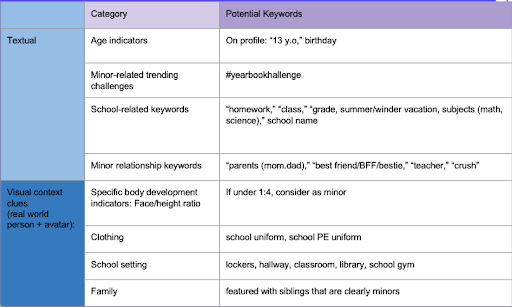
Figure 4: Some potential identifiers of minor users without having to rely on avatar appearance and self-declared age data
Whose Definition of Safety?Currently, it seems that many platforms define minor safety in a way that would take them along the path of lowest legal liability and reputational risk. So this would include a minor’s freedom from situations that would expose them to physical and graphic violence, sexual exploitation, cyberbullying, hate speech, etc.
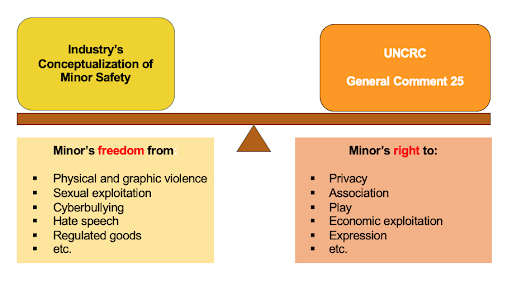
Figure 5
But can platforms also consider a more comprehensive definition of safety that ensures minor users the freedom to exercise their full spectrum of rights? Is an approach of minimized risk inadvertently restricting younger users’ experiences online and consequently pushing them away from these platforms? Do platforms’ emphasis on ensuring the safety of minor users simultaneously ensure minors’ dignity as users?
The UNCRC, or the United Nations Convention on the Rights of the Child, was adopted in 1989 and is currently one of the most reputable documents that outline the rights of the child. In 2021, some additions were made to the UNCRC, called General Comment 25, which explains how member states should implement the UNCRC in relation to the digital environment, namely a child’s right to:
● Privacy: importance of protecting a child’s personal information and their digital activities and the importance of obtaining informed consent when collecting data from them (i.e.: ensuring that a child’s data is not collected from them unknowingly through third party ads)
● Association: the right to meet, exchange and deliberate with others online (i.e.: when children meet each other in VR worlds)
● Play: age ratings or features should not curtail children’s access to the digital environment or interfere with their opportunities for leisure (i.e.: introduction of new features to restrict access to certain content)
● Economic exploitation: not only protecting children from trafficking and harmful goods, but also ensuring their right not to be commercially exploited by a platform’s monetization practices (i.e.: the economy of children laboring excessively to obtain in-platform currency)
Age-Gating and Children’s Freedom of Expression
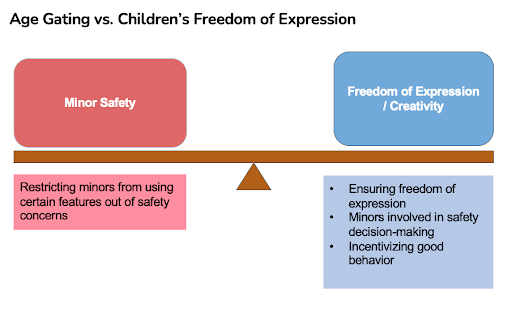
FIGURE 6
In the process of implementing age-gating features to protect minors from potential predators and harmful content, how are we also considering a minor’s right to freedom of expression or exercising creativity on the platform? In other words, does safety always trump other values that may be equally as important to minors from their perspectives?
When the platform makes the decision to restrict minors from using a feature on live streaming or talking to certain users in a virtual world, is a complete ban from using a function based on age also considering that group’s freedom of expression? If a platform decides to abruptly disallow certain features for minor users after receiving bad press, how will these decisions affect user experience?
Currently, Facebook and TikTok have separate portals for parents and guardians that provide them with strategies for ensuring their children’s safety and privacy on their platforms. Less discussion, however, has been on whether publishing more guidelines for parents are actually shifting the platform’s responsibility to individual users. Not all guardians have the same ability to monitor their children’s activities online - some simply do not have the time and others do not possess the level of digital literacy required to do so. Also, not all children live in a stable household where parents or guardians are continuously present, facts that reveal the assumptions platforms make about the concepts and role of the family and parenting.
Age Labeling and Children’s Privacy Rights
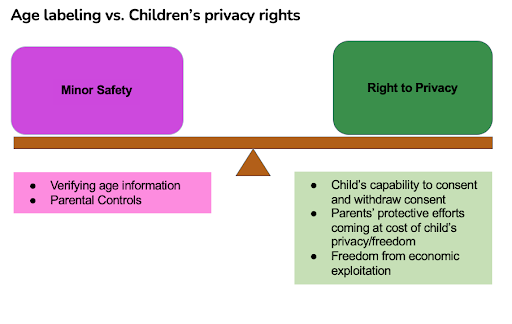
FIGURE 7
Another area platforms prioritize when it comes to children’s safety is related to the safeguarding of children’s privacy, aka, ensuring the safety of minor users’ data. Currently there are strict rules around retaining minor data, such as the Children’s Online Privacy Protection Act (COPPA) that restricts the collection of data of users younger than 13 years of age.
Data on minor users’ ages may help platforms develop age verification technologies, but how much consent is obtained from the users themselves when requesting this data? According to Child Rights International Network, no personal data should be collected from children without their informed consent, which should be “a clear, accessible and unambiguous statement of how it is to be treated” that also allows children to withdraw their consent. Children who have yet to develop the capacity to grant such consent should not be asked to provide any personal data online.
Sonia Livingstone, a professor of Social Psychology at the London School of Economics specializing in children’s rights on the Internet, goes beyond the issue of consent and brings forth the issue of age identification as potentially restricting freedom of expression. She calls the surveillance of children online “a digital panopticon” that can always identify a child, as well as their whereabouts and needs. In a similar vein, other scholars such as Deborah Lupton and Ben Williamson have noted that children today have been datafied “in utero” even before birth, with their health and personal data being shared with not only companies but with healthcare providers and, after birth, public and private education systems. Datafied children subject to constant surveillance may help parents and educators understand their child more comprehensively, but it comes at the cost of exposing the child to “social sorting” where data determine important future life decisions such as employment, thus rendering children into “algorithmic assemblages” that obscure who they are as a person defined by personality traits and potential that cannot be quantified.
Conclusion
All this is not to say that minor users should be given free rein to engage in illegal activity or be exposed to harmful content, but to call for platforms to be more comprehensive in their definitional work on harm and safety. Are there ways for platforms to place trust in minors to take charge in certain safety decisions that affect them? Are there also ways for younger users to contribute in what they view as a fair sanction for certain behaviors, or even to help moderate in areas where our technology is not yet developed, so we can get a better communal agreement between the platform and user?
For example, what does bullying and harassment, a popular category often included in platforms’ community guidelines, really mean for younger users? VRChat’s policy on bullying in its community guidelines simply tells users not to engage in “Repeatedly approaching an individual with the intent to disturb or upset.” Roblox merely tells users not to single out another user “for ridicule or abuse.” Yet, for younger users, having gossip about them spread behind their backs or being accused of copying another user’s world or avatar design may feel equally as caustic as physical acts of shoving or name calling. In this sense, are there gaps in understanding harm and safety between the platforms’ adult policy-makers versus the minor users who are governed by such norms?
As younger users are incentivized to go on quests to earn Zems, Minecoins, or Robux, how can platforms incentivize these users to voluntarily act in a way that benefits other members of the community? Are there ways platforms can entrust minors with the role of community moderators who can help monitor their own communities and provide insights in areas where commercial content moderation teams have no visibility? For example, if user A was reported more than an X number of times by fellow users in the last hour for the same violation, can the company take this as legitimate evidence and temporarily disable that user for 24 hours before they can come back again? Users would be able to provide insights to the platform on what types of conduct and behavioral-based interactions their current policy may lack. What’s more, allowing minors to partake in communal governance may provide a valuable lesson for younger users on the importance of prosocial behavior.
Another way for platforms to gain direct feedback from users can be through the implementation of text boxes during reporting where users can describe the issue in their own words to help the platform better determine content removal, instead of just an option to flag bad content. Allowing the user to report in their own words has been proven to provide emotional release and increase gratitude towards the platform. Although the implementation at scale may be challenging for growing platforms, there are some platforms that are doing this already, such as Zepeto which allows younger users to directly voice their concerns and provide context through a free-form text box that accompanies a user report.

Figure 8: Text box on Zepeto where users can directly provide context around content that made them feel uncomfortable in their own voice before they submit the report to the platform
At the end of the day, however, the importance of allowing minors to provide input on safety is as important, and perhaps more empowering, than only teaching them to be wary of potential dangers and imposing restrictions. By allowing minors to actively contribute to decisions that affect them, younger users will have a heightened awareness of how their decisions online can affect other users, and, in the same process, inform platforms on how to approach safety in a more inclusive and accountable manner.
Biography
Kyooeun Jang is a doctoral student at USC's Annenberg School for Communication and Journalism. She is interested in the influence of big tech on shaping platform governance and developing norms for interpersonal communication in social extended-reality platforms. Before coming to USC, Kyooeun also worked in the tech industry, specializing in ads solutions as well as in user content operations in the trust and safety space.
March 15, 2023
The Fight Between Liberal Arts and STEM Majors
The following post was created as part of the assigned work for Henry Jenkins's PhD seminar, Public Intellectuals. The goal of the class is to help communication and media studies students to develop the skills and conceptual framework necessary to do more public-facing work. They learn how to write op-eds, blog posts, interviews, podcasts, and dialogic writing and consider examples of contemporary and historic public intellectuals from around the world. The definition of public intellectuals goes beyond a celebrity-focus approach to think about all of the work which gets done to engage publics -- at all scales -- with scholarship and critiques concerning the media, politics, and everyday life. Our assumption is that most scholars and many nonscholars do work which informs the public sphere, whether it is speaking on national television or to a local PTA meeting.
"Your liberal arts student is useless to the country's development. Otherwise, why wouldn't the Americans limit the entry of liberal arts students into their universities?" a drunk elder, of a significantly higher social class than our family, said at our Saturday night family dinner. He developed his argument further by telling a kid from my family who had just started high school, "Your brother can't change because he is too old to study STEM, but you still have the chance to choose. You can study liberal arts on the side, but you should never waste your opportunity for education by not studying a STEM major." He explicitly expressed his negative attitude toward the student who studies liberal arts, similarly his approbation for the student who studies STEM.
Disregarding how nonsensical his argument can be, this conflict between liberal arts and STEM majors has been debated in China for the past few decades. I was personally irritated by his statement, not because I am part of the liberal arts student community, but by how extreme and uneducated he, someone who has a high social class and potential power in Chinese society, is in this area. The legitimacy and objectivity of the drunk elder’s statement aside, his speech and statement reflected a traditional STEM-major first education culture within China, even in the broader Asian context: STEM majors are “better” than liberal art majors.
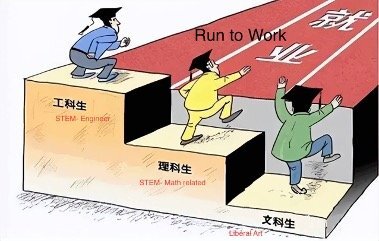
FIGURE 1
To understand the statement, we need to read the history of the development of China’s education system and its original purpose. China’s education system was modeled after the Soviet Union, focusing on the development of industrialization. Despite the later transformation to a more China-unique system, its core and the STEM vs. liberal arts divide have not been replaced. The traditional STEM courses, which are science and computer science-related majors in the United States context, have been highly appreciated by the government. This appreciation continued to develop with the invasion of Japan, the war in Vietnam, and an eye towards boosting the country’s development. As a matter of fact, without the development of scientific study, China wouldn’t even have had the chance to be the world factory that it is. Within this period of time, China’s focus on liberal arts studies has significantly decreased.
This situation is quite different from the role that liberal arts studies played in China’s historical development. When we trace back to the earliest intellectuals, like Confucian theory, the hundreds of intellectual thinking genres in the Spring and Autumn War Period, how liberal arts intellectuals Sun Zhong Shan and Lu Xun helped form the current structure of the People’s Republic of China, these histories clearly demonstrate how liberal arts public intellectuals helped create China as a country. This makes it even more ironic that studying liberal arts has been despised and disdained by most people in China from the beginning of the industrial development period. It wasn’t until recent decades that the government started to bring liberal arts majors back to the public’s attention, but they are still incomparable to STEM majors. The argument that this article is trying to state is not that the STEM major is not worthy of being valued but that both majors should be given similar weight.

Figure 2: English Translation “Scientists and engineers all over the country strive to learn new skills and transform nature to develop the driving force of industry”
Thus, it can easily be concluded that the previous education system and its culture of preference for STEM majors are products of the country’s goals in the ongoing competition of economic development and desire to push the limits of technological knowledge. Since China belongs to a state-orientated economic market, STEM major-related jobs and academic professionals gained massive financial support from all directions. As the government promotes field development and promises more benefits for related jobs, it inspires an enormous number of citizens to take that field as a goal for personal development. Some of the common dialogue statements include:
You study liberal arts because you can’t do well in STEM.”
“What kind of jobs will you be able to get by studying liberal arts?”
“How do you make a living by studying literature or sociology?
What’s more is that during family dinners on the occasion of festival celebrations, people who study liberal arts are questioned constantly about their choices since their families do not believe that their studies will help him/her to make a living in this society. The most common impression that people have about those who study liberal arts is of people who can only talk but can barely act or make progress for society. Then, we can take those perspectives to understand that the determination criteria of “better” for Chinese culture is more about job-seeking and profit-making. But let's think critically about this question. For a country and its society to continue development, will studying in a singular, narrow manner truly be sufficient?
Before talking about how narrowing majors can be troublesome for personal and social development, we need to know how China’s education system is structured. It is very different from the United States. In high school, students will not be able to select STEM major-related courses but stick to more traditional courses, including Chinese, Math, English, Chemistry, Physical, Biology, Politics, History, and Geography. Then the students are separated into liberal arts and STEM/science majors to select some courses to test on Gaokao. (There are many different majors in China, like law school and medical school, etc; we are mainly talking about the situation as it relates to liberal arts majors and STEM majors.) Then in the Chinese college education system, the course of study for a STEM major means that you will spend most of your time studying major-related courses. STEM courses will include computer science, electrical engineering, data science, etc. Liberal arts courses will include sociology, psychology, literature, etc. There are not many choices to continue to expand and select courses from other majors unless students spend their spare time reading and studying by themselves. In the meantime, many students do not learn what most of their major courses will be until they enter college, which can be painful and late for many students to decide their path. Take STEM courses as an example; in the United States, some argue STEM courses are offered too late since they require students to cultivate interest at an early age. Moreover, STEM courses have always focused on the winner-take-all belief, which means they are naturally aligned with elitist culture: the “winner,” who has accomplished great work in the field, is praised by the whole community about everything that they do. This is in conflict with Chinese communist culture. The existence of elitist culture in the Chinese social context raises tremendous challenges and unexpected issues for a student’s personal development. Those students focused mainly on STEM courses are forced to disregard the study of literature and how to build up personal connections; ironically, they don’t even have time to learn how to talk to girls.

figure 3
What are some examples of the consequences for students who fall into a culture that prefers STEM major study and disregards liberal arts? The primary function of the study of liberal arts is to define and understand social or human values in this changing world. Without them, students will lack understanding of human networks, leaving them with a rather superficial cognitive depth for things that we encounter daily and an inability to control advanced technology in these areas, like ChatGPT.
Values are the fundamental concepts that keep the world functioning. Money, Country, Weapon, Life, Death, Culture, and Relationships are all part of values. The transformation of a country from a traditional imperial political structure to the current democracy or communist structure is all a product of the values-thinking process. Values also determine how people act and behave, what people should and should not do. Laws, morals, and ethics all result from the value-thinking process. What the liberal arts mainly study is societal and human values. Internet violence is a classic example of how people take advantage of the functions of technology but cannot think more critically and reflect on the consequences of their behavior. Without liberal arts study, there will be no ethical and moral thinking, reflections on law and order, or educational and philosophical thinking. Students cannot adapt and analyze the constant changes in human society, and they likely won’t have these skills after entering the workforce where they may have a more detrimental impact on society.
Consider ChatGPT. The function of this latest AI technology can easily replace most human’s repetitive and calculative work. For example, ChatGPT can easily draft news articles, conduct brief market research, and write a high school or even a college essay. Figure 4 shows a response that ChatGPT generated for the topic, “Should colleges cancel liberal arts courses?”

figure 4
As the response shows, the AI has the ability to gather a massive amount of information and to conduct a rather critical thinking analysis, which would outcompete many lower-level job positions. What’s more, GitHub has developed an AI program that can automatically debug code if the program is built with the code stored in their dataset. These technologies have become advanced enough that the market will not need low-level computer science employees in the future. Such AI technologies can potentially be applied to all STEM fields, which means that the requirements for future STEM employees will be much higher than they are today, and the potential study duration may continue to expand. As the creator of ChatGPT, Sam Altman, mentioned during an interview, the future generation may be separated into two groups: those who are AI above and those who are AI below. Being AI above will require the employee to outcompete AI levels of analysis and information gathering. It is undoubtable that in the future, the education system will require students to become AI above.
For students to be competitive with future AI technologies, students should study more multi-disciplinary knowledge to increase their creativity and critical thinking ability. Such students will have the cognitive depth to understand things not only through a singular perspective but though diverse and holistic ones. In the meantime, it is also essential for students to have the ability to handle those technologies properly, without using them as cheating tools. With the help of AI, technologies will likely continue to evolve at a fast rate, which will create this gap between most people’s adaptability and moral code of conduct. Without further pushing people to study more about ethics, morals, law, social, and personal values, society may become a real doomsday cyberpunk game or tv show.

figure 5
Finally, the argument that I am trying to make in this blog entry is to suggest that the combination and equal valuation of liberal arts majors and STEM majors will be necessary for the education system to evolve in the future. The rapid and consistent change in society's values, technological development, and the consequences of international relationships that impact individuals will all require students to equip themselves with the skills that are taught in both liberal arts and STEM majors.
Biography
Botao Xu is a second-year master’s student in USC global communication media program, who has been studying in US as an international student for more than 10 years. My primary focus now is the study of interplay between communication, culture, and capitalism and media representation. They are the person who is too American for the Chinese and too Chinese for the American.
March 14, 2023
Extending the Body: Exploring Protest Posters as Feminist Media in South Africa’s Am I Next? Movement
The following post was created as part of the assigned work for Henry Jenkins's PhD seminar, Public Intellectuals. The goal of the class is to help communication and media studies students to develop the skills and conceptual framework necessary to do more public-facing work. They learn how to write op-eds, blog posts, interviews, podcasts, and dialogic writing and consider examples of contemporary and historic public intellectuals from around the world. The definition of public intellectuals goes beyond a celebrity-focus approach to think about all of the work which gets done to engage publics -- at all scales -- with scholarship and critiques concerning the media, politics, and everyday life. Our assumption is that most scholars and many nonscholars do work which informs the public sphere, whether it is speaking on national television or to a local PTA meeting.
Content Warning: This article contains references to sexual violence.
The Space Between Words and BodiesAm I next? asked my sister, who had called to find out if I had heard about the new anti-femicide movement brewing in the streets of South Africa. Alone in her Johannesburg apartment, news of the brutal rape and murder of 19-year-old University of Cape Town (UCT) student Uyinene Mrwetanya had left her shaken. I opened my twitter app instantly. Upon doing so, I learnt that Nene (as she was affectionately referred to on social media) had been raped twice and murdered by a teller named Luyanda Botha at a Cape Town post office on August 24, 2019. More than 2,700 women were killed, and 30,626 rape cases were reported across South Africa that year. Nene’s case was another addition to alarming statistics that moved thousands of women and allies to the streets. Still on the twitter app, I scrolled through photo after photo of bodies and protest posters weaving between one another outside Cape Town’s parliament. In close up shots, people held their own posters with the words Am I Next? printed across paper.
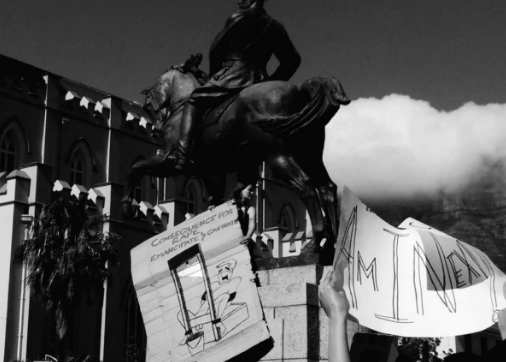
Figure 1: Image via Twitter @Uyonel_
In others, posters with trending hashtags or names of victims were shared and held between several people.

Figure 2: Image via Twitter @MyLifeAsSne
In aerial shots, it was hard to tell which poster belonged to which body. And, at times, difficult to identify where one body ended and another began.
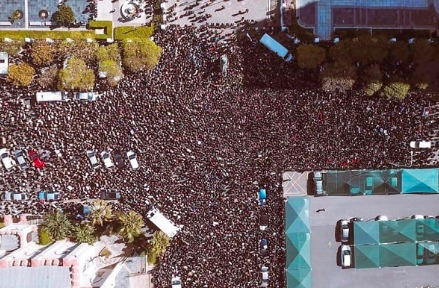
Figure 3: Photo via Madeline Hislop
Through these photos, my curiosity about the relationship between bodies, posters, and words in spaces of protest was born. As a graduate student of global media and communications, I began to ask questions of sexual assault protest methods. When thinking about South Africa’s Am I Next? movement, I realized that the protest poster is a tool that feminists use to turn their own bodies into feminist media. When used in protest, the poster becomes an extension of the body. This highlights the body as a site of transformation. It’s a site of potential and power.
Reading Black Female PainSo, what is feminist media? It’s rooted in an interdisciplinary understanding of feminism, the media, and the spaces at which they overlap. At its simplest, a feminist medium is a material with transmittable qualities that operates in favor of liberation. Initially a hashtag, the Am I Next? movement began as a digital tool to raise awareness and an online space for feminist expression. Understanding the origins of the movement allows us to understand the ability of feminist mediums to evolve across time and space. The viral hashtag is what moved many bodies from behind digital devices to the streets of Cape Town. With this in mind, I wonder:
How do viral hashtags transform when attached to the human body?
Does attaching text to the Black female body in protest make Black female pain easier to read?
And if so, how does this complicate our understanding of what it means to write and read with the body?
Writing the Body by Writing with It
On the African continent, scholars often say that women who riot and women who write have historically been different kinds of women. Feminist scholar Smimakele Dlakavau (2017) rejects this idea and tells us that writing women and rioting women can occupy the same body. Another feminist scholar, Pumla Mqola (2017), takes this a step further by suggesting that writing and rioting is the same thing. The act of holding a written sign during protest, I believe, is a direct manifestation of this argument. Protest signs can be thought of as transforming the human body into an always-on media exhibition. In doing so, the text of a poster is humanized by the person who holds it. At the same time, the body is transformed into a text. These transformative processes are especially powerful when we think of the body as a site of social control. In the context of a sexual assault and femicide protest, claiming control of the body’s form is a type of resistance worth recognizing.
Many of the slogans onAm I Next? protest posters spoke directly to quotes and tweets that were widely circulated online. This included phrases such as “no means no,” “enough is enough,” “stop killing us” and more.

Figure 4: Photo via Facebook/Michelle Shelly Borrusso
Expressions that mostly existed in the digital world were brought to life in physical form. This was achieved through the act of feminist making. Scholars often discuss feminist making as a practice that connects online communication with creative craft work.
In an attempt to honor this act of making, I created a spoken word poem. The poem speaks to my own experiences with assault and the collective experiences of those who took part in the movement. The piece is named after scholar Dorothy Ko’s (2005) haunting question: What does the body leave behind after life expires? This question, followed by the first section of the poem, is a eulogy for what is lost when a body is subjected to such violence. The second section of the poem uses words pulled from Am I Next? protest posters to suggest a collective state of protest and a collective act of writing. In the final section of the piece, I emphasize the strength of body memory. I also speak to the constant precarity of the female body through the final line of the poem: Am I Next?
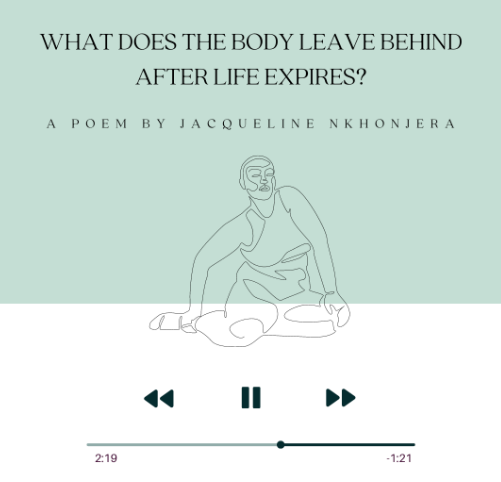
FIGURE 5
The Power of the CollectiveI used my voice—and therefore my own body—to write my spoken word piece. Despite this individual act, my goal is to move attention towards the collective nature of the poem. This collectivity underscores the power of gathered bodies in symbolic and physical space. By gathering outside parliament and the streets of Cape Town, Am I Next? protestors strengthened the effect of their bodies as feminist media. By showing up with posters (many of which had the same slogans) protestors chose to appear in identical written form. This act of repetition and the use of words borrowed from movements such as The Fallist Movement and anti-Apartheid protests created the opportunity for collective protest that reached across the boundaries of bodies and time.
Shedding Light on Shortcomings
That said, it is important to recognize the risks and limitations that accompany a movement such as Am I Next? In the words of scholar Sarah Ahmed (2017), a movement requires us to be moved. Ultimately, it is necessary for us to be critical of what exactly it is that moves us. Among the many assaults and murders that took place in South Africa in 2019, why was Nene’s particular case the final straw? Which bodies are granted the privilege of commemoration when subjected to violence? And in the end, whose body carries enough weight to break the camel's back? I don’t suggest that her social position as a young student at an elite university is the only reason for the popularity of her case. But I do believe that such factors should not be ignored in the quest for feminist protest that honors the struggles of all types of people. In some ways, even this blog post falls short. Here, I present the literate body as a norm. To applaud the use of protest posters is to applaud a form of protest that excludes those who cannot read and write. The use of the protest posters, and my transformation of them into poetry, limits reading and writing with the body to that which is written and verbalized. There are plenty of other important ways to communicate.
The Body as a Feminist Material

FIGURE 6
The body is a feminist material that Am I Next? protestors used to build a world where violence against women was called by its many names. A world most alive in the very moment of protest, it followed in the footsteps of many other street protests. The protest poster was the canvas on which this renowned social movement was nurtured. Both transmitter and receiver, the protest poster inspired the essence of a new movement and reflected the survival of those that came before it.

March 13, 2023
Self-Dissection Through My Obsession with LEGO
The following post was created as part of the assigned work for Henry Jenkins's PhD seminar, Public Intellectuals. The goal of the class is to help communication and media studies students to develop the skills and conceptual framework necessary to do more public-facing work. They learn how to write op-eds, blog posts, interviews, podcasts, and dialogic writing and consider examples of contemporary and historic public intellectuals from around the world. The definition of public intellectuals goes beyond a celebrity-focus approach to think about all of the work which gets done to engage publics -- at all scales -- with scholarship and critiques concerning the media, politics, and everyday life. Our assumption is that most scholars and many nonscholars do work which informs the public sphere, whether it is speaking on national television or to a local PTA meeting.
I have a clear understanding of myself. I am not someone who has the willpower to persevere in doing something. My endurance is poor: when I was in the 800-meter race in middle school, I was among the front-runners in the first lap but always fell behind from the second. Once I lose interest or enthusiasm in something, I cannot persist through will power.I am interested in many things, but these interests often fade quickly. Therefore, when others ask me what my hobbiesare, I am embarrassed to mention those hobbies that I lose interest in after only a few minutes. I feel that the time andeffort I put into them, as well as my level of proficiency, do not qualify me to claim them as my hobbies. If I keep doing something for years, the only motivation toward it is my passion. Thus, I prefer not to use the word “persist” to describe my behaviors.

Figure 1: My LEGO Collections
As for the question of what my hobbies are, one answer is certain: LEGO. I am very sure that LEGO is my favorite, and my passion for it has never diminished. LEGO is not cheap, but compared to other things with the same price, I would not hesitate to spend the money on LEGO. The time I enjoy most when I’m home alone is when I’m sitting on the floor in front of my sofa with my back leaning on it and assembling LEGO on the tea table. At the same time, random variety shows on TV provide some background noise for this entertainment space. I’m completely immersed in this space and don’t allow anyone or anything else to disturb me. I silence my phone and put it aside. I fully focus on the bricks. They give me a chance to take a break from the chaos and pressure of daily life. I imagine myself as the LEGO Minifigure in that world. I even use “spiritual lego Mini figure” as my nickname in video games.

Figure 2: My Minifigure Factory Set
At first, my love for LEGO was an intuition. Later I started to think about it with rationality. I suspect one of the basic logics behind my love for LEGO is my obsession with miniature versions of common items.
I can’t remember when I started to be obsessed with all kinds of tiny things as a kid. In my sentimental memories, I see myself repeatedly being attracted by the sand table models at real estate sales offices while my parents were having aconversation between adults with the salesmen. My dad always made the joke: “Doudou (my nickname) loved visitinghouses,” implying that I was interested in expensive shopping. I used to believe the joke was right, but then I realized it was only half true.
I loved sand tables: I loved to see the full view of the communities on the sand table when the buildings were being constructed in the real site; I loved to see cars and people standing still on the sand table and moving in my mind; Iloved to turn on and turn off the light button to see the color of warm orange filling up every room in the buildings, imaging the tiny people lived for real. However, the in-person room tour never appealed to me as the sand table did. Atthat time, I was too young to notice that I had no interest in bringing my imagination of the sand table life into real life and too young to figure out why. I believed my interest lay in the desire of buying a house.

figure 3: An Example of Sand Table Model
When I was older, middle and high school age, I didn’t have much time to hang out at the sales office. I gradually forgot my obsession with the sand table model of real estate (I didn’t realize the difference between them at that time), until one day when my high school set up a sand table model of the campus. Looking at the miniature of the surroundings that I knew like the back of my hand, a similar feeling to that as I stood aside at the sand table in a real estate sales office suddenly arose. Overlooking the campus I commuted to and from every day from a high perspective brought me a sense of peace and comfort. I was capable of “walking” through the entire campus in a second with only a glance. At that moment, I could not be more certain of my obsession with miniatures.
Lately, I’ve found that Johan Huizinga’s concept of “free play” could partially explain my obsession with LEGO and miniatures. “Free play” suggests escapism, viewing play as a free activity standing outside ordinary life and serving as an alternative to social life’s serious duties and obligations. As a result of being outside ordinary life, Huizinga also believes that play is connected with no material interest and no profit can be gained from it. “Free play” suggests a rigid distinction between real life and the game, forming a “magic circle” to protect the temporary, limited perfection as an alternative to the imperfect reality. In the LEGO world built with bricks, the sense of weakness in real life is minimized to the greatest extent. Due to the huge difference in volume, I have supreme control and power in the miniature world. For the simplest example, it might take me three hours to clean up my 750 square foot apartment, but cleaning a whole LEGO house only requires me to wipe it with a cloth a few times. In reality, I lack the strength to push my sofa, but in the LEGO world, I can even install it on the roof.
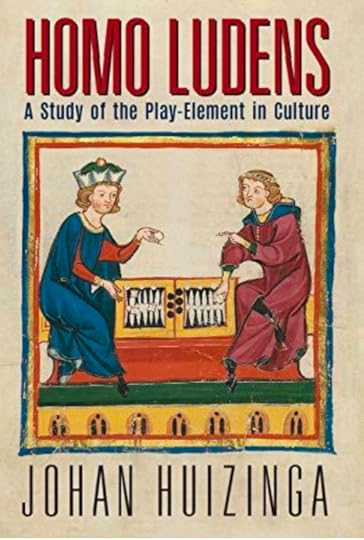
figure 4: Homo Ludens by Johan Huizinga
As an alternative to real life, it’s essential for the play world to be separated from reality to protect its fantasy. Similarly, sometimes people are attracted by movie scenes and plots, imagining themselves as the characters, even if the characters are confronting difficulties or experiencing a dramatic life. The reason for this situation is they clearly know that they are not and will not truly be in the scenes.Thus, what they see is only the structural aesthetics of cinematic arts. It is the same logic as why I never bring my imagination of miniature models into real life. Trifles and troubles in reality will ruin the charm of the play world. It is fascinating because it is fictional.
Separation does not mean disconnection. For me, if there was no connection between the play world and reality, the appeal would be located nowhere. This is why I like LEGO and miniature models that imitate real-life scenes. The play world as an alternative to real life has dual meanings. It provides more possibilities than real life; thus, it has to be based on real life to expand upon these possibilities. It can neither be completely detached from reality nor duplicate reality.

figure 5: LEGO Sets by Theme
However, personal freedom, another essential aspect promised by the “magic circle” for unlimited interaction and self-expression, is not applicable to my situation. I only purchase LEGO sets by theme: he Creator Expert collections, which includes sets of the most famous building in the world like the Taj Mahal, Sydney Opera House, Big Ben, etc, and setsbased on franchises like The Simpsons, Pirates of the Caribbean, Harry Potter, etc. are my favorites. I’ve never purchased the Classic collections which come without instructions to encourage open-ended building play and inspire any imagination. In some cases, freedom means having more control over life. Yet, freedom without a boundary means chaos to me. I need someone else to provide me with a graspable guide—in the LEGO world, it is the handbook of building instructions that provides me with a sense of order. If I were given unlimited freedom, my perfectionism would trigger my anxiety. In the process of organizing random bricks, I cannot control my intention to pursue perfection, but I do not believe I have the ability to achieve it. Under such pressure, I find it difficult to begin the creative process, since I’ve already assumed that I’m unlikely to meet myexpectations. What is even worse is that I don’t know where my expectation lies. I only know it is way too high for me to reach it. In contrast, pre-designed sets give me a sense of security because I’m informed what the final product will be in advance so that I have a certain range to select from.

figure 6: The Simpsons House
By analyzing my obsession with LEGO, I realize that I still lack self-discipline, as usual. It’s hard for me to make any decision at the start-up stage. I may be overwhelmed by too many choices and be too concerned to move forward. Therefore, I need an external force to control the range of choices to guide me forward. Overall, a leader isessential for me to develop my career. I am not suited for self-leadership.
BiographyJun (Willow) Wang is a 2nd year graduate student in the dual degree program in MA in Global Communication at USC Annenberg School of Communication and Journalism and MSc in Global Media and Communications at LSE. She earned her dual bachelor’s degree in Communication from China Agricultural University and University of Colorado Denver. Her research interests include gender studies, queer theory, pop culture, subculture, and neoliberalism.
Henry Jenkins's Blog
- Henry Jenkins's profile
- 184 followers



